MILITARY UNITS FORMED IN UZBEKISTAN. THE BATTLE FLAGS
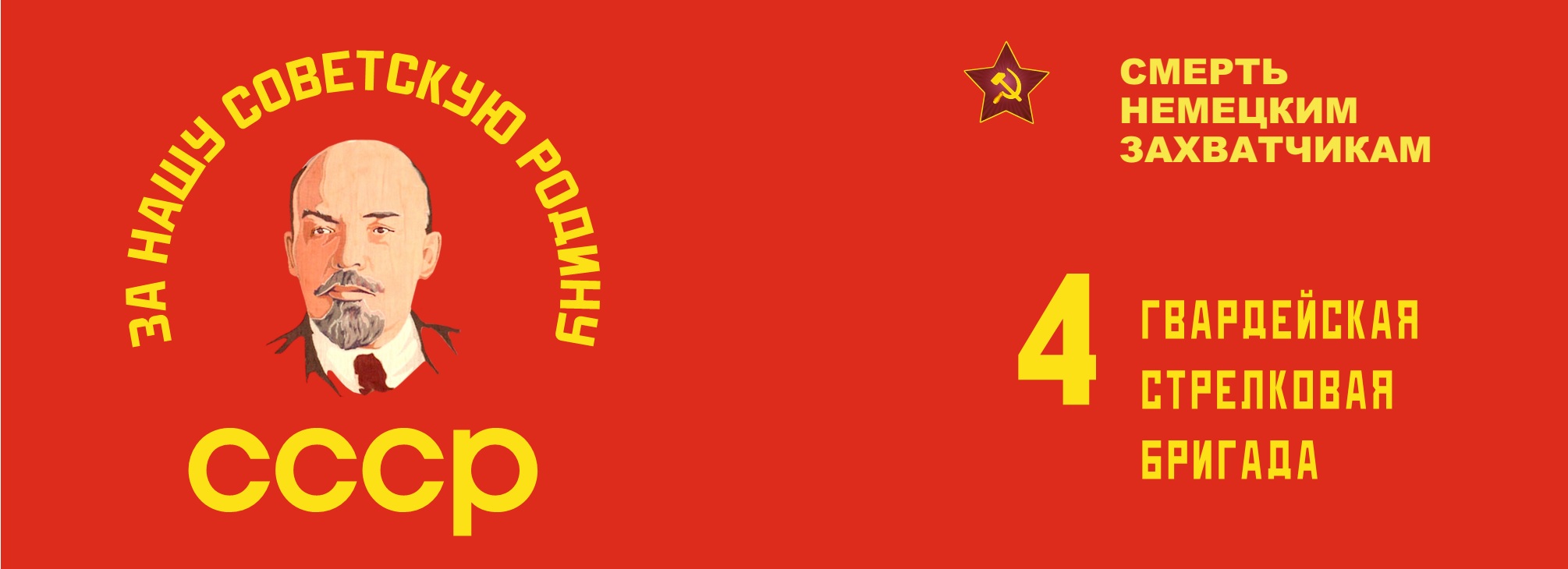
THE BATTLE FLAG
OF THE 4TH GUARDS RIFLE BRIGADE
In November 1941, several cadet brigades were formed on the basis of military schools of the Central Asian military district, including the 38th separate cadet brigade.
In the offensive battles of the Western and Kalinin fronts, cadet brigades covered their battle banners with unfading glory. For the valor and courage shown, the 38th Separate Cadet Brigade was transformed into the 4th Guards Rifle Brigade.
Warriors of the 4th Guards Rifle Brigade showed high combat activity in fierce battles in the North Caucasus.
During the extremely tense situation in the North Caucasus in August 1942, the 4th Guards Rifle Brigade of the 389th Rifle Division together with other formations were urgently transferred from the Black Sea coast to the Terek, Sulak, Samur rivers, where they became part of the 9th army and took up defense on one section of the right bank of the Terek River, in order to prevent the enemy from breaking through to Grozny and Baku.
The robust and courageous defense of these compounds thwarted all the enemy’s attempts to break the resistance of the Soviet troops at the turn of the Terek River and break through to the North Caucasus.
For the differences in the battles in the North Caucasus, the 4th Guards Rifle Brigade was awarded the Order of the Red Banner. In July 1943, on the basis of the 4th and 10th Guards Rifle Brigades, the command formed the 108th Guards Rifle Red Banner Division, which went a glorious battle path until the end of the war.
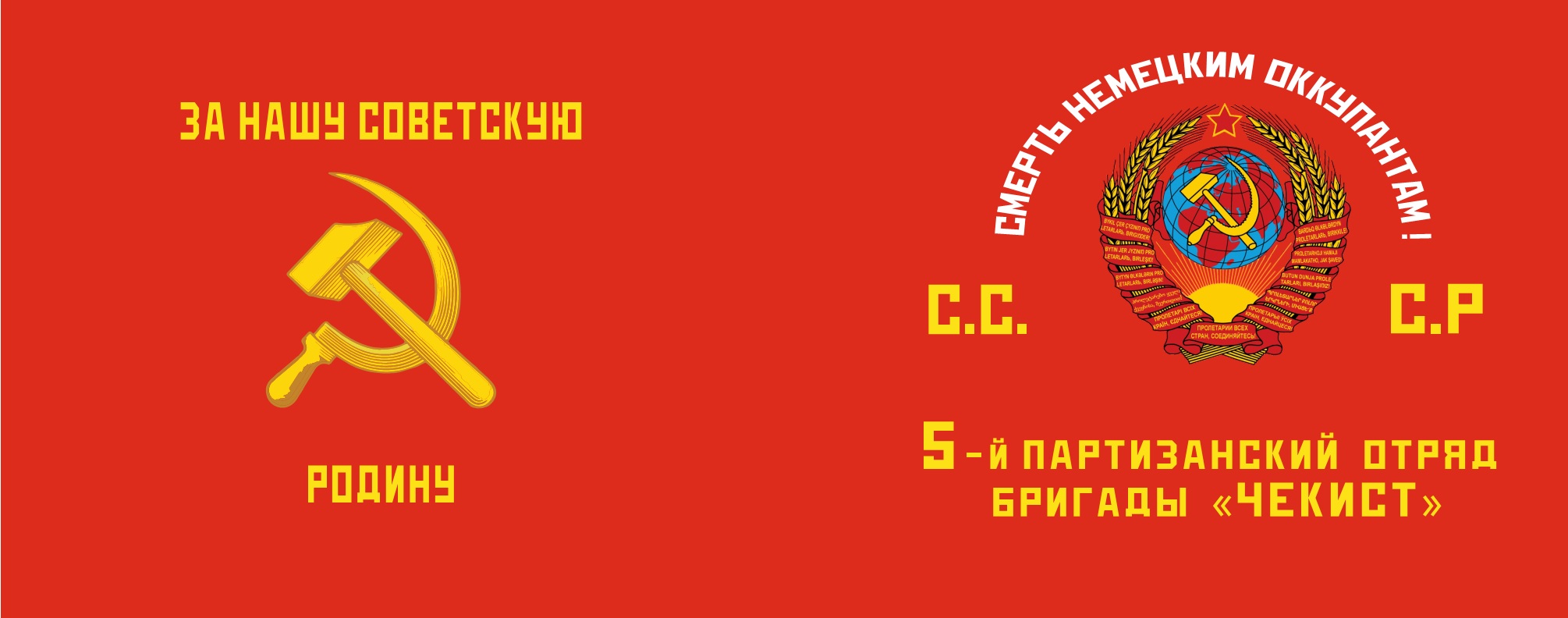
THE BATTLE FLAG
OF 5TH DETACHMENT OF THE “CHEKIST” PARTISAN BRIGADE
The Chekist partisan brigade operated in the occupied territory of the Shklovsky, Belynichsky, Kruglyansky, Tolochinsky, Orshansky and Lepelsky districts and other areas of the Vitebsk and Mogilev regions of Belarus. The composition of the brigade was multinational. In its ranks next to the Belarusians were Russians, Ukrainians, Kazakhs, Uzbeks, Mordvinians, Tatars, Georgians and representatives of other peoples.
It was created at the end of May 1942 from the units of G.A.Kirpich (later the first partisan detachment) and I.D.Bulanova (later the 10th partisan detachment) as the “Association of partisan detachments”.
In July 1942, the brigade was named as “Chekist”. Its commander was G.A.Kirpich; Commissars were F.M.Sedletsky, F.I.Bukshtynov; chiefs of staff were I.D.Bulanov, R.M.Sevastyanov. In September 1942, during the fighting with punishers, the “Chekist” brigade broke through the blockade and entered the Lepel district.
In April 1943, the brigade returned to its area of deployment, entered the VOG at the Mogilev underground regional committee of the Communist Party of the Soviet Union and the brigade was assigned number of the 15th, the corresponding numbers were received by the detachments.
Partisans fought with the enemy, saved the local population from death and transportation to hard labor in Germany. Operations were carried out on the railways Minsk - Orsha, Orsha - Mogilev.
On June 22, 1942 near the village of Dymanova, Shklovsky District, a detachment of punishers was defeated. May 25, 1943 delivered a simultaneous attack on enemy garrisons in the villages of Klimovichi, Taukachi, Avchinenki, Shklovsky district. In August 1943, 500 rails were blown up on the Mogilev-Lotva railway section.
In August 1943, the brigade (more than 800 partisans and 7 detachments) was transformed into the Shklov military-operational group.
The final chord of the partisan-Chekists’ struggle before joining the units of the Soviet Army was the “rail war” on the night of June 20, 1944. That night, all the railways of Belarus were blown up by the people’s avengers so that the enemy could not use them in the upcoming Belarusian operation, the largest operation of World War II.
The operation was successful. On June 5, the Belarusian operation began. On June 28, the “Chekist” partisan brigade joined forces with General Burdeyny’s tankers in the area of Goenka-Zadniy Bor villages in the Kruglyansky District.
Among the participants in the “Chekist” partisan brigade, the most famous commander of the reconnaissance department of the 5th partisan detachment was Mamadali Topivoldiev, who was from the Pandigan village of Rishtan district of the Ferghana region. The Nazis promised a huge reward behind the brave partisan’s head. In a special order, the occupation command promised for the capture of Topivoldiev 25 thousand Reichsmarks, a villa and a vacation home. Six months for the living, three months for the dead. But Mamadali was elusive. The fame of his heroic deeds boomed throughout the partisan region. He blew up on the roads cars and trucks of the enemy. On July 17, near the village of Vorontsevichi in the Tolochinsky district, in reconnaissance, he launched a short distance from the enemy’s convoy and opened fire on it, thereby deciding the outcome of the fight, having lost more than a dozen dead and wounded, the enemy fled.
On August 26, near the village of Logovschina in the same Tolochinsky area he fired at an enemy group. Taken aback, the Nazis retreated. The documents indicate that Topivoldiev participated in battles and ambushed with the detachment and in battles waged by the brigade.
Moreover, in the battles of April 20 and June 1, Topivaldiev was part of the assault groups.
Having infiltrated Tolochino, in the garrison of which there were also Uzbeks, Topvoldiev dismissed them that they were deceived by the enemy. All of them with their weapons joined the ranks of the people’s avengers.
By the Decree of the Presidium of the Supreme Soviet of the USSR of August 15, 1944, the glorious son of the Uzbek people Mamadali Topivoldiev was awarded the title of “The Hero of the Soviet Union”. He was also awarded the Order of the “Red Star” and the Medal “For Courage”. And by order of the Belarusian headquarters of the partisan movement of June 29, 1944, he was awarded the 1st degree of “Partisan of the Patriotic War” medal.
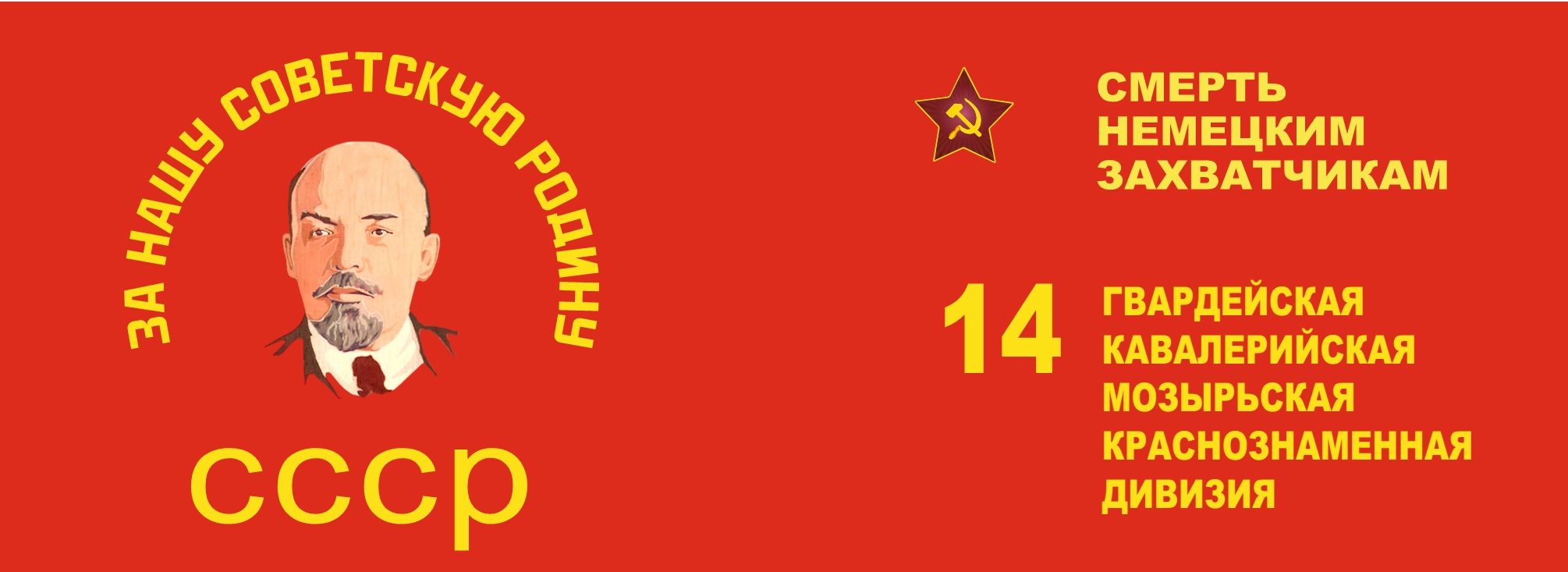
BATTLE FLAG
THE 14TH GUARDS CAVALRY OF THE RED BANNERED MOZYR DIVISION
Before the war, the division was stationed in the city of Fergana.
Previous name was the 21st Cavalry Division.
During World War II, the division received a baptism of fire in the battle of Smolensk. As part of the 8th cavalry corps, it participated in the counterattack of the Southwestern Front.
It distinguished itself in the battle of Stalingrad.
For exemplary fulfillment of command assignments, valor and heroism of personnel, the 21st Cavalry Division was transformed on February 14, 1943 into the 14th Guards Cavalry Division.
The 14th Guards Cavalry Division participated in the battle for the Dnieper:
In 1944, it liberated Belarus. For the liberation of the cityMozyrit was awarded the honorary name Mozyr.
In July 1944, the division took part in the Lublin-Brest offensive operation of the 1st Belorussian Front.
For military distinctions in the capture of the city of Lublin, the division was awarded the Order of the Red Banner. For the exemplary performance of command tasks in battles for the cities of Tomaszow, Lodz, Kalisz and the breakthrough of the fortifications of the Pomeranian Wall, it was awarded the Order of Suvorov of 2nd degree.
The division ended the battle in Berlin.
More than 13 870 soldiers of the 14th Guards Cavalry of the Red BanneredMozyr Division were awarded orders and medals,30 division soldiers were awarded the title of“The Hero of the Soviet Union”.
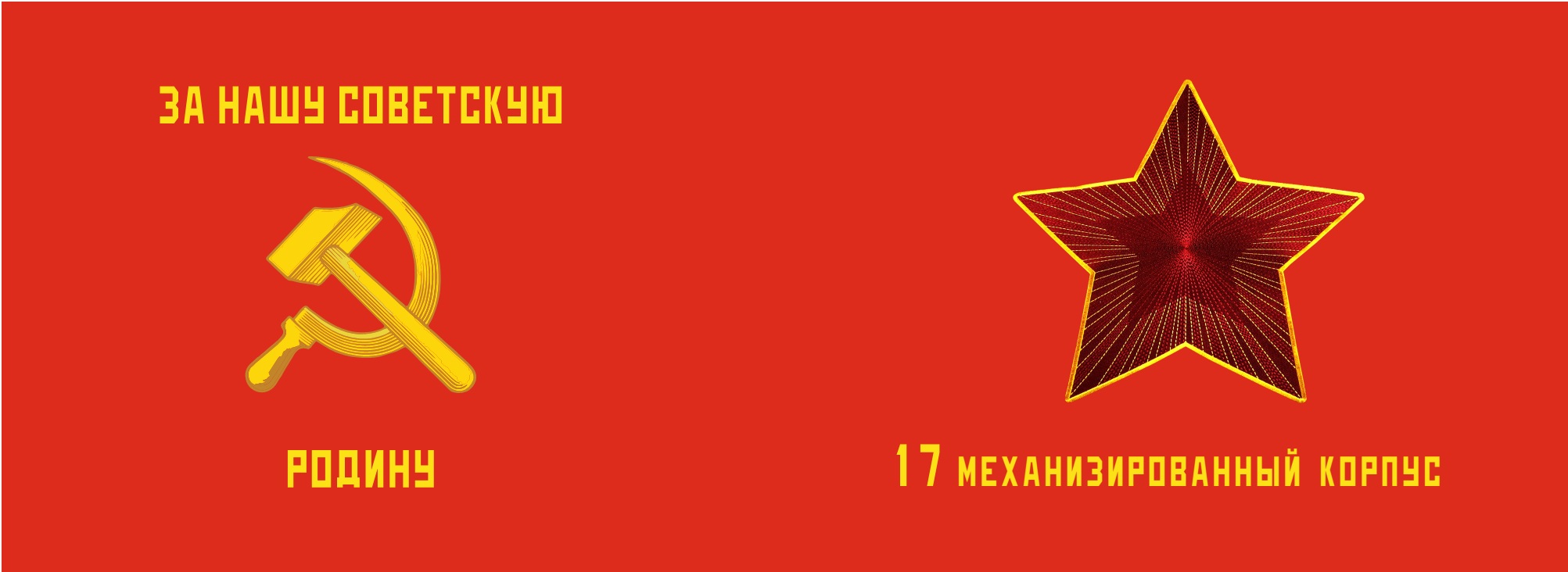
THE BATTLE FLAG
OF THE 17TH MECHANIZED CORPS
Commander was Major General M.P. Petrov.
The 17th Mechanized Corps was a military unit of the Armed Forces of the USSR during World War II.
The formation of the corps began in the Belarusian military district in early 1941. On June 26, 1941, without completing formations, the corps was destroyed by the advancing German units.
Structure:
The 27th Panzer Division (Colonel A.O. Akhmanov; Novogrudok)
The 36th Panzer Division (Colonel S.Z. Miroshnikov; Nesvizh)
The 209th Motorized Division (Colonel A.I. Muravyov; Ivye)
The 22nd Motorcycle Battalion
The 532nd Separate Communications Battalion
The 80th Separate Motorized Engineering Battalion
Fights on the Bialystok ledge were on June 22-25, 1941.
It was as part of the army from June 22, 1941 to August 1, 1941.
Given the incompleteness of the formation, the headquarters of the Western Front did not set any combat tasks for the corps; however, with the approach of the enemy to the Baranovichi, the commander of the 4th Army, Major General A. A. Korobkov, nevertheless decided to use the available forces in defense. On June 26, practically unarmed and uncontrolled parts of the corps were dispersed by the advancing forces (the 2nd Panzer Group of Army Group Center).
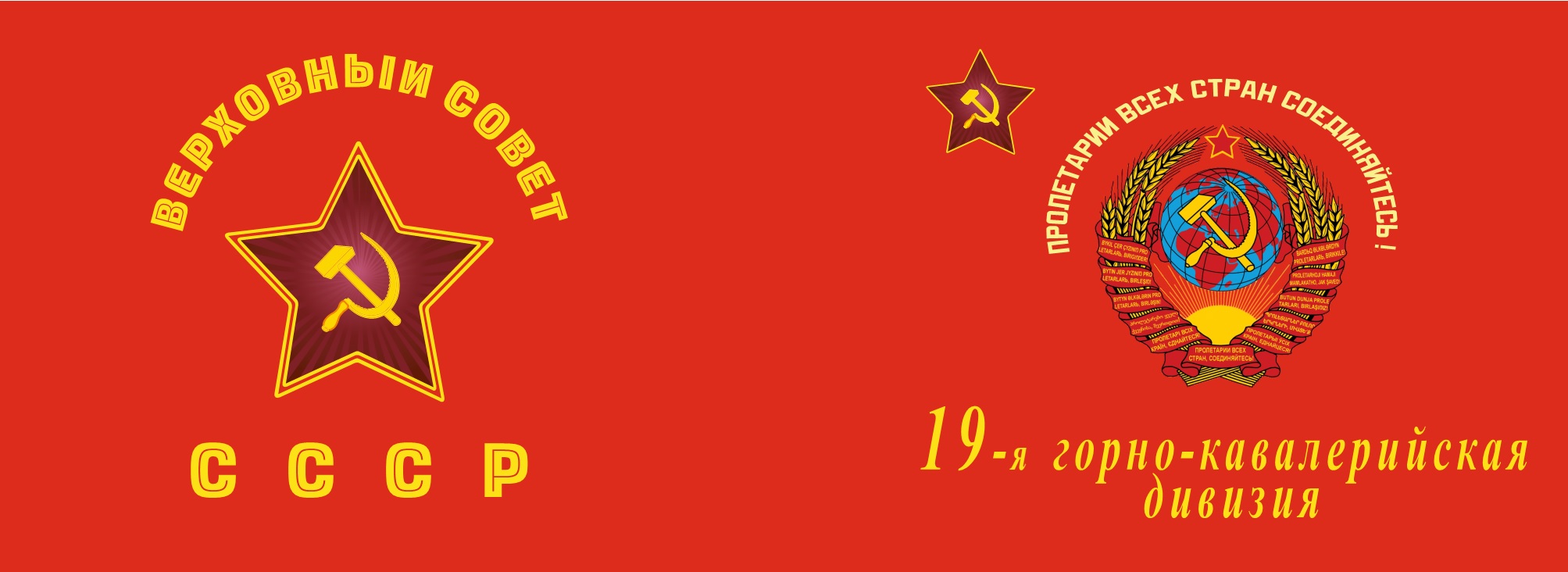
THE BATTLE FLAG
OF THE 19TH MOUNTAIN CAVALRY UZBEK DIVISION
At the end of 1920, the 1st Bukhara Cavalry Regiment was formed, which was the main core and personnel of further formations, from which the 19th Cavalry Division was gradually created.
By the order of SAVO № 308/102 of October 1, 1927, a Separate Uzbek Combined Team was formed, uniting the Uzbek national units.
The brigade included: Management, the Uzbek Cavalry Regiment, the Separate Uzbek Infantry Battalion, and the Separate Uzbek Cavalry Battery.
The team was stationed in Samarkand.
It was renamed into the 19th Mountain Cavalry Division by Order of the NCO № 072 dated on May 21, 1936.
By November 1, 1940, it had:
4,049 personnel, including 382 commanders, 603 junior commanders, 3064 ordinary officers; 3691 horses, including 2912 drill horses, 600 artillery horses, 179 convoy horses; 80 cars, including 8 cars, 46 trucks, 26 special vehicles; 6 tractors; 6 motorcycles; 2654 rifles and carbine; 100 light machine guns; 54 easel machine guns; 6 45 mm cannons, 32 76 mm mountain guns, 4 122 mm howitzers; 11 BT-5 tanks; 17 armored vehicles.
It located in Samarkand, the 27th Mountain Cavalry Regiment was Katta-Kurgan.
In March 1941, it was turned to the formation of the 221st Motorized Division of the 27th Mechanized Corps.
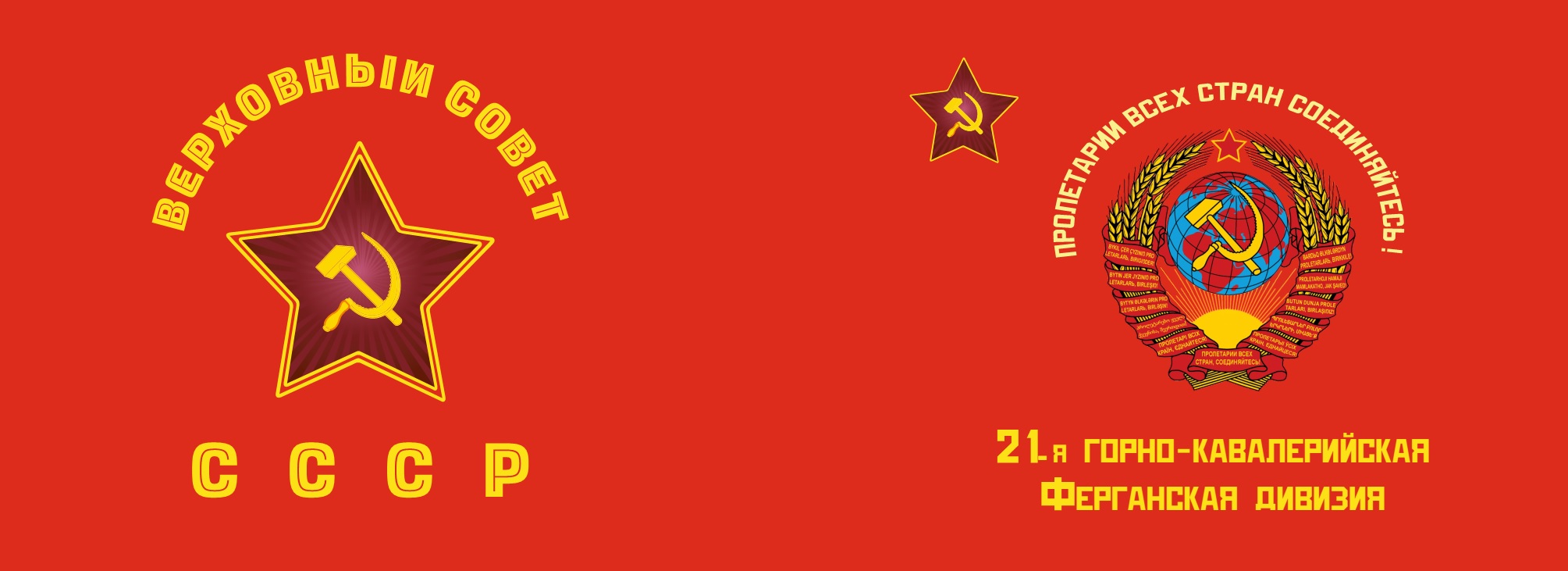
THE BATTLE FLAG
OF THE 21ST MOUNTAIN CAVALRY DIVISIONS
The 21st Mountain Cavalry Division was one of the oldest and most distinguished divisions of the Turkestan Military District.
Until 1941, the division was stationed in the city of Fergana.
On July 27, 1941, units of the division immediately went into battle with the enemy and took part in the battle of Smolensk. As part of the troops of the 28th Army of the Western Front, it took part in a counterattack on the right flank of the 2nd Panzer Army of Guderian with the aim of breaking through to the 20th and the 16th armies encircled in the Smolensk region.
Unloading at Unecha station, units of the division began to advance along the Krichev-Roslavl route to connect with units of the 52nd Cavalry Division. Within 2 days, they fought back the fierce attacks of units of the 3rd tank division of the enemy in the vicinity of the Ponyatovka and Zimnitsa stations, and then were forced to retreat southward to the Krasnopolie area with rear-guard battles.
Despite the extremely unfavorable situation, the soldiers of the 21st Cavalry Division fought bravely. In the battle for the Ponyatovka station, units of the 67th and the 17th Cavalry Regiments, with the support of the 22nd Horse Artillery Division, destroyed more than 25 tanks, 3 mortar batteries, and up to two infantry battalions.
Taking the control of the villages of Krivoles, Pustosel, Ozhogi, and Shibnevo on August 2, the warriors of the 112th Mountain Cavalry Regiment and the 23rd Armored Division showed high combat activity and determination.
In early October, the 21st Mountain Cavalry Division as part of the operational group of the Bryansk Front, Major General A.N. Ermakov defended east of the farm Mikhailovsky to Yampol. After a stubborn battle, the division retreated to the Hinelsky forest and, together with the 52nd Cavalry Division, began to break out of the encirclement through the Bryansk forests.
On October 21, the division left the encirclement and was sent for replenishment.
The 21st Mountain Cavalry Divisions of the 8th Cavalry Corps participated in the counterattack of the Southwestern Front.
In October 1942, this corps was transferred to the Stalingrad direction. As a result of determination and courage, Soviet tankmen and cavalrymen surrounded several enemy formations west of Stalingrad. All the enemy’s attempts to break out of the encirclement were thwarted by decisive action, in particular by the soldiers of the 21st Cavalry Division.
For exemplary fulfillment of command assignments, valor and mass heroism of personnel, the 21st Cavalry Division was transformed on February 14, 1943 into the 14th Guards Cavalry Division.
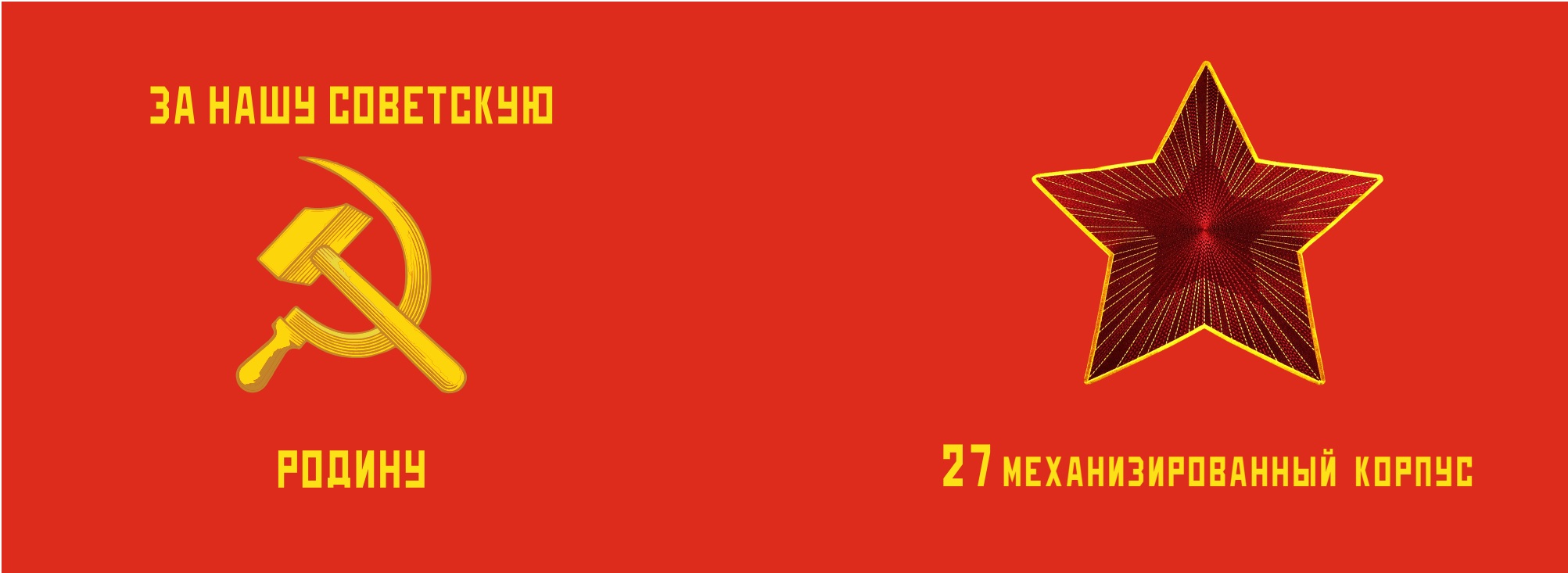
THE BATTLE FLAG
OF THE 27th MECHANIZED CORPS
The commander of the Corps was Major General Petrov Ivan Yefimovich.
The deputy of Corps’ commander for political affairs:
Sviridov Alexander Pavlovich, Brigadier Commissar (from April 19, 1941 to August 9, 1941)
The Chief of Staff of the Corps was Colonel Menshov Vasiliy Vladimirovich.
The Head of the Intelligence department of the headquarters was Major Karl Sarapu.
The Deputy Head of the Department of Political Propaganda was Senior Battalion Commissar Bikritskiy Matvey Moiseyevich (from April 1, 1941 to August 20, 1941).
Other commanders:
The 29th (from April 5, 1941 – the 31st) Motorcycle Regiment:
The Deputy Regiment Commander for political affairs was senior political instructor Mazalov Stepan Ivanovich.
The 553rd Separate Communications Battalion:
The Deputy Commander of the battalion for political affairs was senior political instructor Salikhov Shagi Zaripovich.
The 84th Separate Motor-Engineering Battalion - military unit 2874:
The Deputy Battalion Commander for political affairs was political instructor Sertakov Mikhail Petrovich.
Structure:
Office housing.
- The 9th Panzer Division - military unit 5757
- The 54th Panzer Division - military unit 1227
- The 221st Motorized Division - military unit 1222
- The 29th (from April 5, 1941 – the 31st) Motorcycle Regiment - military unit 2890
- The 553rd Separate Communications Battalion - military unit 2857
- The 84th Separate Motor-Engineering Battalion - military unit 2874
- The 127th Separate Corps Air Squadron - military unit 5654
- The 722nd Field Postal Station
The 27th Mechanized Corps (military unit 2850) was formed in March 1941 in the Central Asian military district in the city of Mary. It included the 9th Panzer Division, the newly formed 53rd Panzer in the city of Kizil Arvat and the 221st Motorized Division in Samarkand. Major General Ivan Yefimovich Petrov was appointed commander of the corps.
The 9th Panzer Division was armed with most of the tanks that participated in the Soviet-Finnish War of 1939-1940 with significantly expended motor resources and underwent major repairs. There were at least 220 tanks, mainly combat training. In the spring of 1941, the division received new automotive equipment. From the autumn of 1940 to the winter of 1941, the regiments and battalions of the division participated in a series of exercises, including district exercises. In 1941, the division received a tank battalion from the Moscow military district, equipped with 50 BT-7M diesel tanks and 1 BA-20 armored car. In general, the division was a well-trained compound.
Since the formation of the corps in the troops, enhanced combat training had unfolded.
In March 1941, the commander of the 9th Panzer Division received a cipher telegram about the planning of combat training for March-May. All regiments and battalions held tactical exercises, live firing, practicing the interaction of the units and their knocking together. By the summer of 1941, the 9th Panzer Division became one of the most combat-ready formations of the district. The crown of the combat training was the command-and-staff exercise led by General Staff generals M.N. Sharokhin and S.M. Shtemenko, held in the area of the city of Mary in the first half of 1941. The results of the exercises were positive.
Housing location:
- The Administration of the Corps and the 9th Panzer Division – in Mary;
- The 9th Panzer Division – in Mary, the 9th MSP – in Bayram Ali;
- The 53rd Panzer Division – in Kizil-Arvat;
- The 221st Motorized Division – in Samarkand.
On June 22, 1941, the corps met at a place of constant deployment. The corps management remained insufficiently prepared for command and control of the military operations of the troops. The 53rd Panzer Division was poorly prepared.
The administration of the corps, a separate communications battalion, and the reconnaissance battalion departed from their permanent deployment at the end of June 1941.
On June 27, 1941, loading into the railway echelons and dispatch to the west of the first echelon of the 9th Panzer Division began. The remaining thirty-four echelons of the division followed. The route of movement was Mary - Tashkent - Orenburg - Voronezh. And then all the formations and parts of the corps moved to the Soviet-German front.
On July 8, 1941, in the morning, the head train of the 9th building had already approached Voronezh.
On July 8, 1941, the General Staff, based on the experience of the early days of the war and as a result of heavy tank losses, decided to disband the corps link of the armored forces and reorganize the existing tank divisions into new states. The tank division was supposed to have 217 tanks, a smaller number than before, instead of a howitzer artillery regiment, the compound received an anti-tank artillery regiment. Reforms affected primarily tank formations not yet involved in hostilities.
On July 10, 1941, the 27th Mechanized Corps was included in the 28th Army, the commander of the army Lieutenant General Kachalov, whose headquarters was located in the city of Kirov (150 km north of Bryansk).
The 27th Mechanized Corps was reformed. Now the composition was as follows: the 104th Panzer Division (formerly the 9th Panzer Division (formations of 1940)), the 105th Panzer Division (formerly the 53rd Panzer Division), and the 106th Panzer Division (formerly the 221st Motorized Division).
On July 15, 1941, the General Staff adopted a new decision: the management of the 27th Mechanized Corps was disbanded. On July 15, a directive of the General Staff on the concentration of the reorganized the 104th, the 105th, and the 106th Tank Divisions in the area of the city of Spas-Demensk was sent to the commander of the 28th Army.
The further fate of the corps divisions was such. On July 19, in order № 0058 on the completion of the formation of tank divisions, the Deputy Commissar of Defense and the Chief of the General Staff Army General Zhukov included the 104th and the 105th Panzer Divisions formed in the Front of the Reserve Armies. Instead of the 106th Tank Regiment, formed on the basis of the 221st Motorized one, the 106th Motorized Division was formed, in which, until further notice, the second motorized rifle regiment remained, and the 106th Tank Battalion was switched on instead of the tank regiment due to a lack of tanks. The numbering of motorized regiments in the division temporarily gained a serial character – the 1st and the 2nd Motorized Rifle Regiment.
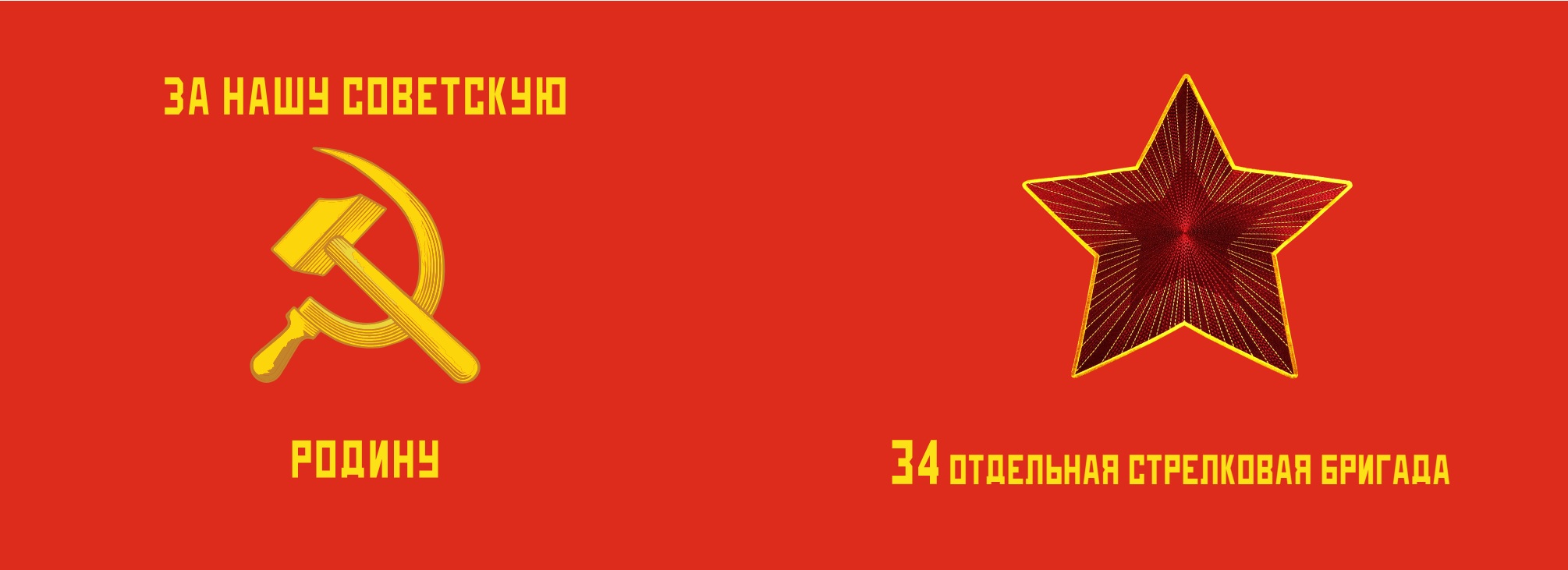
THE BATTLE FLAG
OF THE 34TH SEPARATE RIFLE BRIGADES
The 34th Separate Rifle Brigade was formed in October-November 1941 in the city of Chirchik.
On the basis of the order of the Central Asian Military District Manning Department, by Order № 356 of October 24, 1941 at the Tashkent Red Bannered Infantry School named after V.I. Lenin, 700 people were seconded to the commander of the 34th Separate Rifle Brigade for further service.
At the end of November 1941, the 34th Separate Rifle Brigade (Commander Colonel Pyotr Mikhailovich Akimochkin) was urgently transferred by rail to Moscow, where it was at the disposal of the commander of the 49th Army of the Western Front, and on December 16 it entered into battle with the German fascist troops.
Developing the offensive, the 34th Separate Rifle Brigade, together with other troops, reached Ozhogino and Vorobyevo on December 30, where it had to repel the enemy’s counterattacks. As part of the army, the 34th Separate Rifle Brigade was in the period from December 10, 1941 to April 26, 1942.
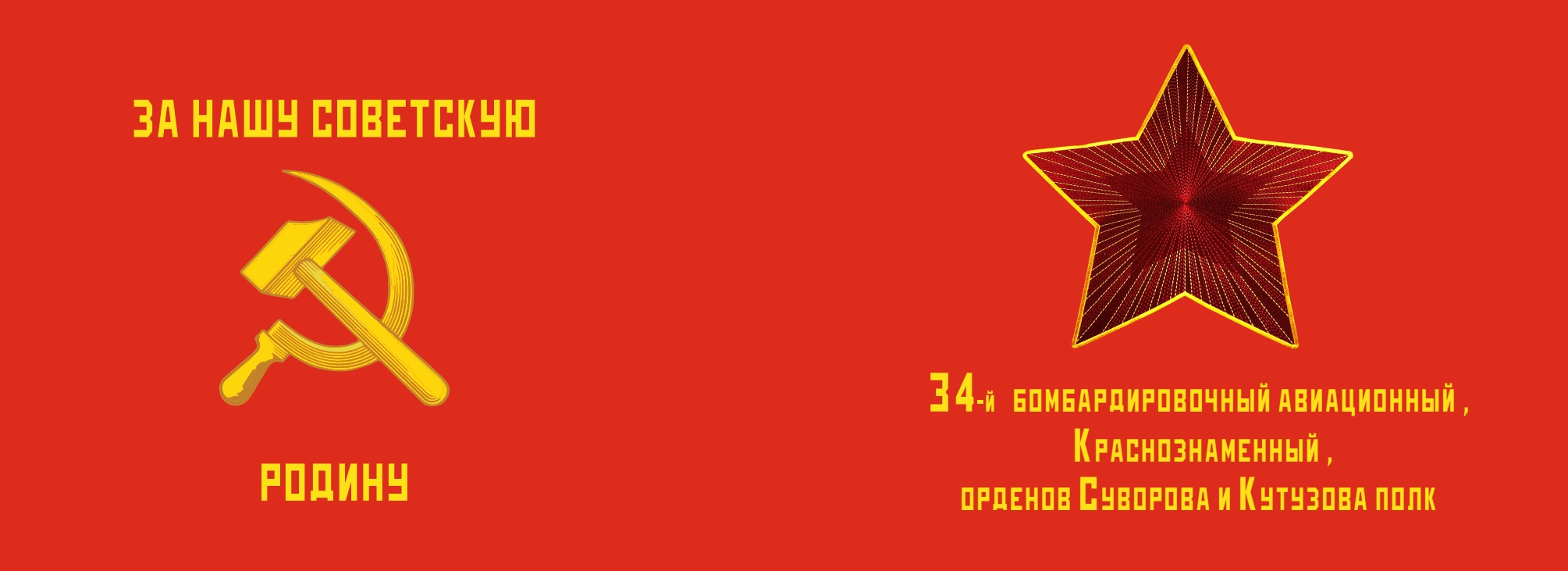
THE BATTLE FLAG
OF THE 34TH TASHKENT AVIATION RED BANNER REGIMENT
ORDERS OF THE SUVOROV AND KUTUZOV REGIMENT
The regiment was formed on June 1, 1939 in the Central Asian military district by renaming the 13th Light bomber Aviation Regiment.
As part of the army during World War II:
from November 16, 1941 to February 17, 1942;
from January 27, 1943 to September 8, 1944;
from November 25, 1944 to May 9, 1945.
On June 22, 1941, it was based in Tashkent, armed with SB aircrafts.
To prevent the danger of bypassing Moscow from the south and provide more effective assistance to ground forces, by decision of the Supreme High Command Headquarters from the Air Force of the Central Asian Military District by October 10, 1941, it had been relocated and transferred to the command of the Air Force commander of the Western Front.
At that time the regiment had 20 SB aircrafts.
From December 3, 1941 until mid-February 1942, it had 2 gardens on the Leningrad Front. During this period, the regiment made 325 sorties, 129 of them were at night. Attacks were inflicted on the railway junctions Novo-Lisino, Chudovo, Stekolny, Vladimirskaya, Mga, Maluksa, Pogost; on enemy clusters, artillery positions and convoys.
February 17, 1942 it assigned to the reserve, retrained in Pe-2. It re-enlisted in the army in January 1943.
From January 1943 until the end of the war it acted as part of 301 dietary supplements.
For exemplary fulfillment of command assignments in battles with the German invaders while taking possession of the city and the fortress, it was awarded the Order of Kutuzov of the 3rd degree on February 23, 1945.
For valor, courage and exemplary performance of combat missions of command during the Berlin operation, the regiment was awarded the Order of Suvorov of the 3rd degree.
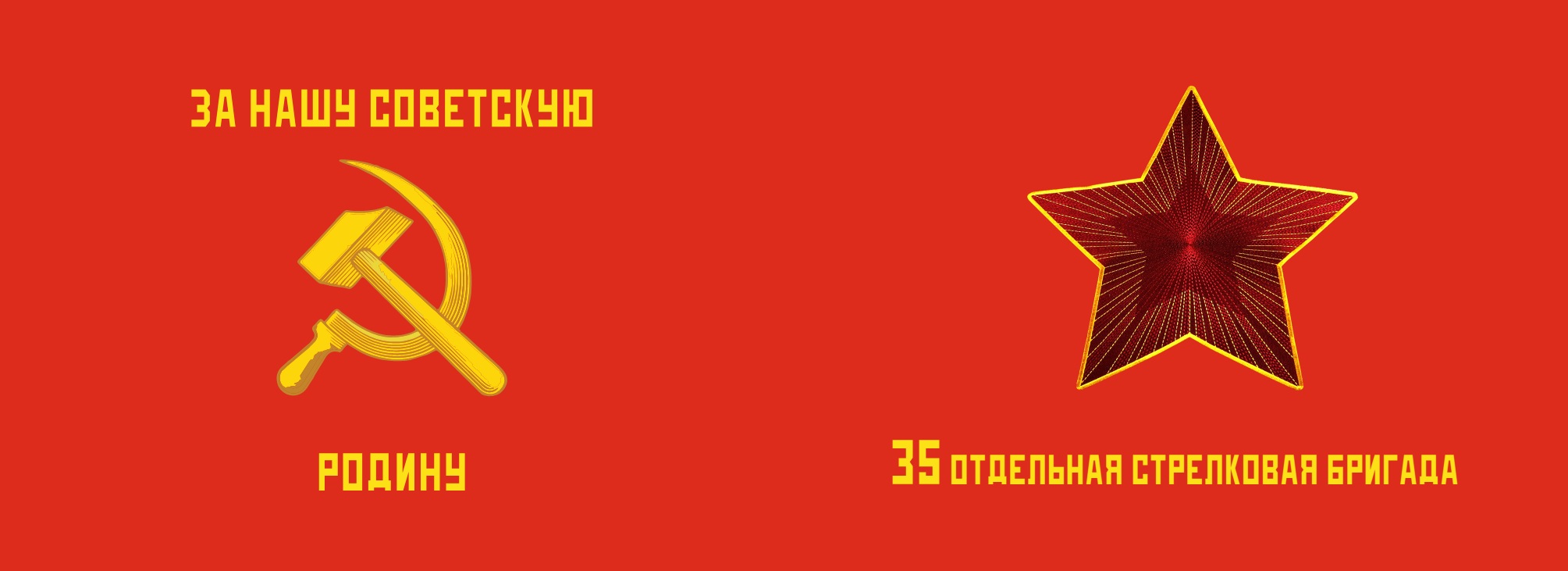
THE BATTLE FLAG OF THE 35TH SEPARATE RIFLE BRIGADE
The 35th Separate Rifle Brigade was formed in October-November 1941 in the city of Chirchik.
Lieutenant Colonel Budykhin Pyotr Kuzmich was appointed as a brigade commander. The brigade included students of the Tashkent Infantry School and the Alma-Ata Machine Gun School, as well as students of the Tashkent Institute of Irrigation and Agricultural Mechanization Engineers, Tashkent Polytechnic and Medical Institute, Tashkent State University and Red Army warriors who completed treatment in hospitals.
By the order of the staffing department of the Central Asian military district of October 24, 1941 № 356, at the Tashkent Infantry School named after Lenin for further service were assigned 400 people at the disposal of the commander of the 35th Separate Rifle Brigade...
In the most difficult days for Moscow, in November 1941, the 35th Separate Rifle Brigade was put into battle on the Istra-Volokolamsk direction.
On the Western Front near MOSCOW in the vicinity of the city of Solnechnogorsk in December 1941, the 35th Separate Rifle Brigade in the 20th Army led the first defensive, and then successfully launched a counterattack against the Nazi troops, tearing in the last “bliskrieg” to Moscow. The battle path of the brigade during the liberation of the city of Solnechnogorsk passed through its southeastern outskirts - the village of BUTIRKI - the village of STRELINO.
In June 1943, the 35th Separate Rifle Brigade was sent to form the 208th Rifle Division (it was finally reorganized on June 16, 1943 in the area of Dorogobuzh, Smolensk region (265 km from Moscow)), which continued the glorious fighting history of the 35th Brigade ...
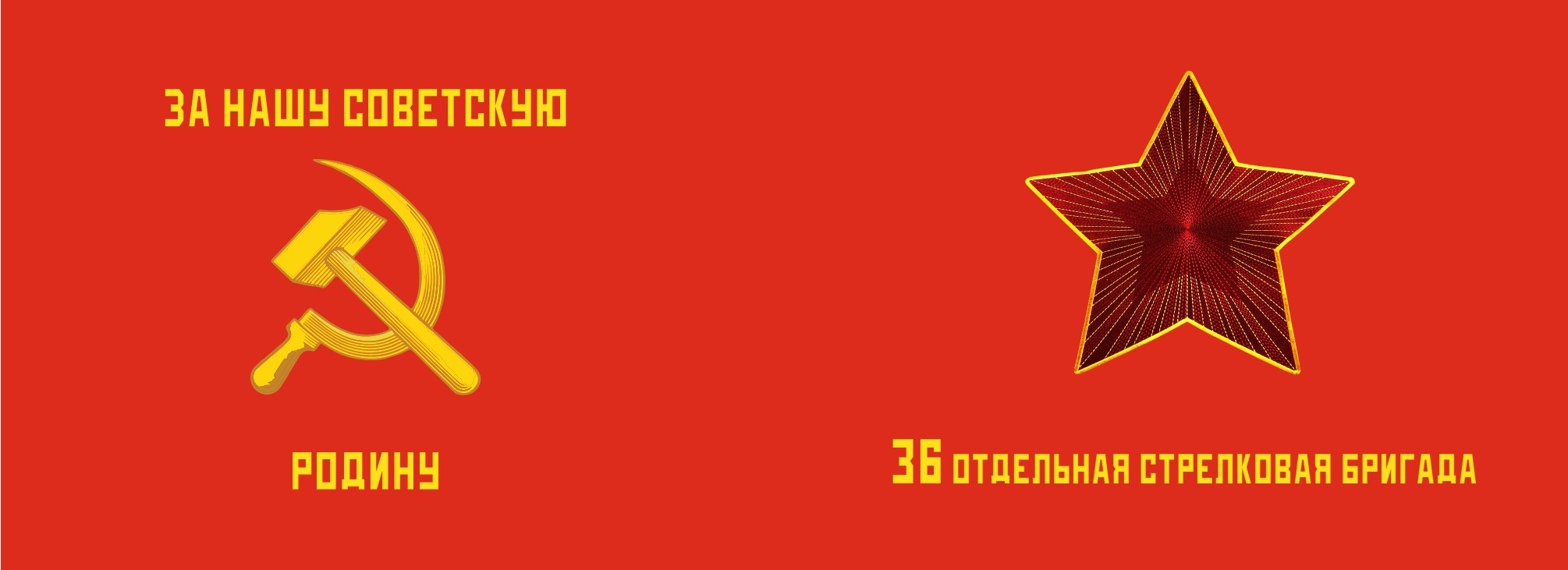
BATTLE FLAG OF THE 36TH SEPARATE RIFLE BRIGADE
The 36th Separate Rifle Brigade was formed from October 25 to November 19, 1941 in the city of Samarkand from cadets of military schools and enlisted personnel of the Uzbek, Turkmen and Kazakh Republics.
On November 29-30, 1941, the brigade unloaded at the Khimki station and occupied the defense of Cherkizovo - Novodmitrievka - Kuskovo.
From December 07, 1941 to January 23, 1942, it conducted offensive battles and liberated 120 settlements of the Moscow Region, including Rozhdestvenno, Kryukovo, Monikhino, Istra, Chertanovo, Vnukovo and others.
In 1942, the 36th Separate Rifle Brigade conducted defensive and offensive battles in the Moscow and Smolensk regions.
In March 1943, the brigade participated in offensive battles in the Smolensk region.
From April to December of 1943, the brigade participated in defensive and offensive battles as part of the Western Front.
From December 1943 to January 1944, the brigade conducted offensive battles in the Vitebsk - Orsha area.
On February 12, 1944, the 36th Separate Rifle Brigade captured the village of Bukhshtany with battle.
On May 8-10, 1944, the brigade was disbanded and units of the brigade were transferred to units of the 5th Army.
The 36th separate rifle brigade during the course of its military journey liberated more than 300 settlements, and more than 3,000 brigade soldiers were awarded orders and medals.
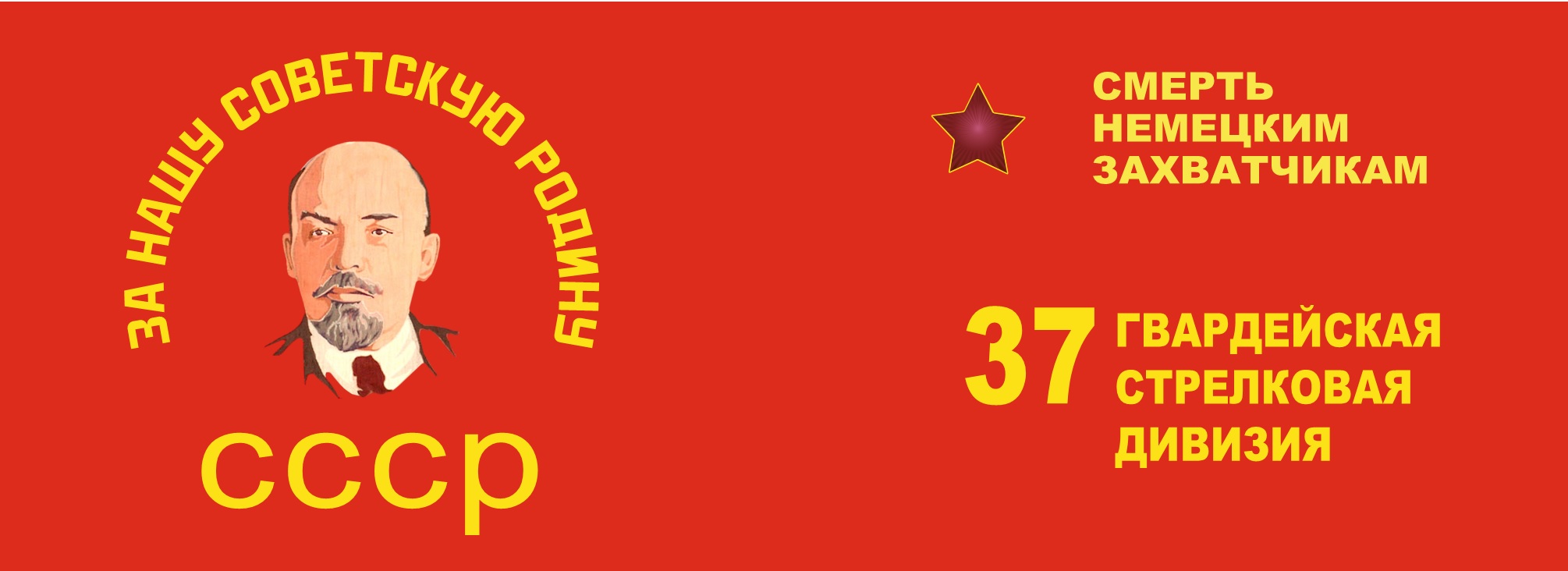
BATTLE BANNER
THE 37TH GUARDS RIFLE RECHITSA, TWICE RED BANNER ORDERS OF SUVOROV, KUTUZOV AND BOGDAN OF THE KHMELNITSKY DIVISION
The division was formed in August 1942 in the Moscow region as the 37th Guards Rifle Division. It was part of the troops of the 4th Panzer, the 62nd, 65th (February 1943 - February 1945 and March - May 1945) and the 2nd Shock (February - March 1945) Armies.
It participated in the Battle of Stalingrad, the offensive operation in the Sevsky direction (February-March 1943), in the Oryol (at its final stage), Chernihiv - Pripyat, Gomel - Rechitsa, Kalinkovichi - Mozyr, Belorussian, Mlava - Elbing, East - Pomeranian and Berlin offensive operations. For military merits it was awarded the honorary title "Rechitskaya" (November 1943), awarded two orders of the Red Banner, orders of Suvorov of 2nd degree, Kutuzov of 1st degree, Bohdan Khmelnitsky of 2nd degree; over 6 thousand of its soldiers were awarded orders and medals, 15 people of the division were awarded the title of “The Hero of the Soviet Union”.
From November 16, 1944 to March 26, 1945, the division was commanded by Major General Sabir Umarovich Rakhimov.
The 37th Guards Rifle Rechitsa had twice Red Banner Orders of Suvorov, and The Kutuzov and Bogdan Khmelnytsky Division was one of 4 awarded the Kutuzov Order of the 1st degree of the Guards Rifle Divisions during World
War II.
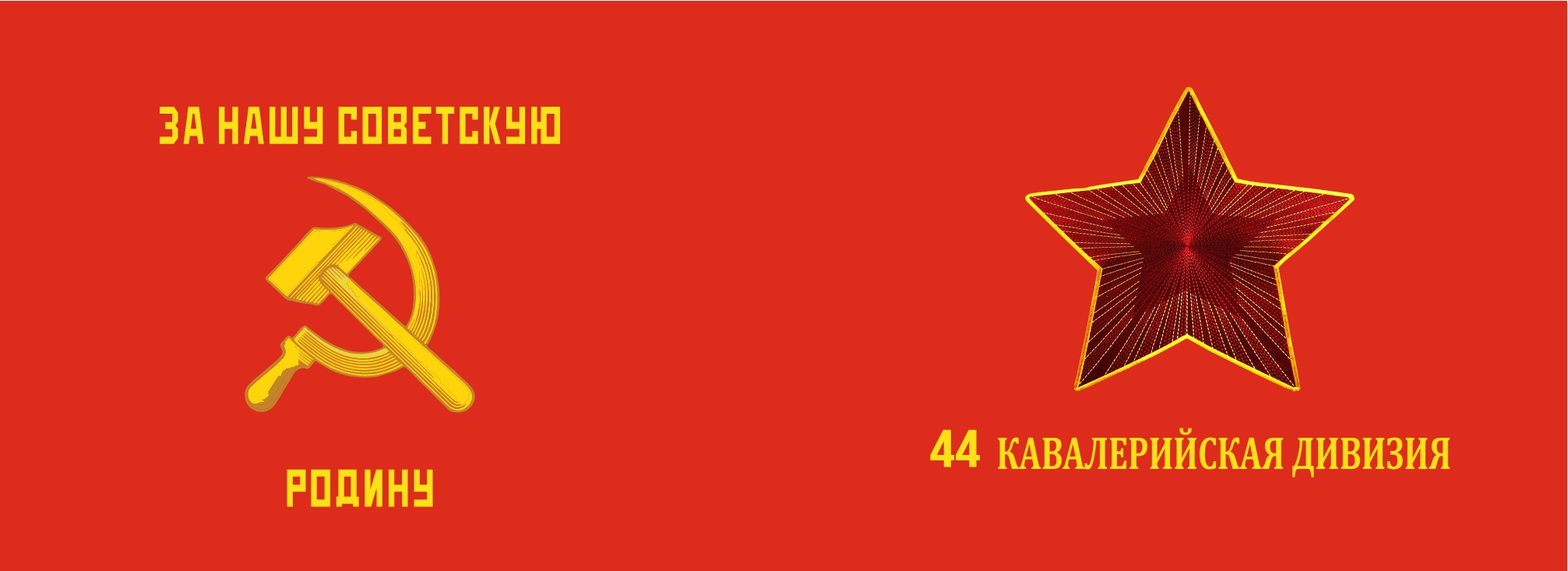
THE BATTLE FLAG
OF THE 44TH CAVALRY DIVISION
Division composition:
The 45th Cavalry Regiment,
The 51st Cavalry Regiment
The 54th Cavalry Regiment,
The 35th Horse Artillery Division,
The 35th Artillery Regiment,
The 29th Separate Communications Half-Squadrons,
The 16th Medical-Sanitary Squadron, etc.
The 44th Cavalry Division was formed in the summer of 1941 in camps near the city of Chirchik, which included the best soldiers of Tashkent, Samarkand, Fergana regions.
The division was to leave for the Western Front as part of the freelance 2nd cavalry group of General O.I. Gorodovikov, but the headquarters of the Central Asian military district did not meet the deadlines for formation, and instead of the 44th Cavalry Division, the 21st Mountain Cavalry Division, already moving in trains, was sent to Turkmenistan to participate on the front. And instead of the 21st GKD, the 44th Cavalry Division soon left for Iran.
From August 27 to September 5, 1941, the 44th Cavalry Division took an active part in the Iranian operation.
From November 14, 1941, the 44th Cavalry Division was in the very center of the battle of Moscow. The soldiers of the 44th Cavalry Division heroically fought near Volokolamsk. In the battles near Moscow, Umar Tairov distinguished himself in liberating the countries of Europe.
In battles near Moscow, the commander of the 51st Cavalry Regiment Valakhov Pavel Vasilyevich distinguished himself. Before the war, by order of the CAMD troop’s № 00147 of July 9, 1941, he was appointed head of the course for Junior Cavalry Lieutenants under the command of the 19th Mountain Cavalry Uzbek Order of the Lenin Division. By a resolution of the Central Executive Committee of the USSR of February 22, 1933, he was awarded the Order of “The Red Banner”. On February 8, 1942, the command of the 44th Cavalry Division was presented with the Order of “The Red Banner”. Under his leadership, the 51st Cavalry Regiment valiantly and skillfully restrained the onslaught of the enemy and destroyed the fascist invaders. In the battle for the village of Nikitsky, Istra district, Moscow region, Valakhov Pavel Vasilyevich was seriously wounded.
In April 1942, the 44th Cavalry Division was disbanded and turned to the formation of the 17th Cavalry Division.
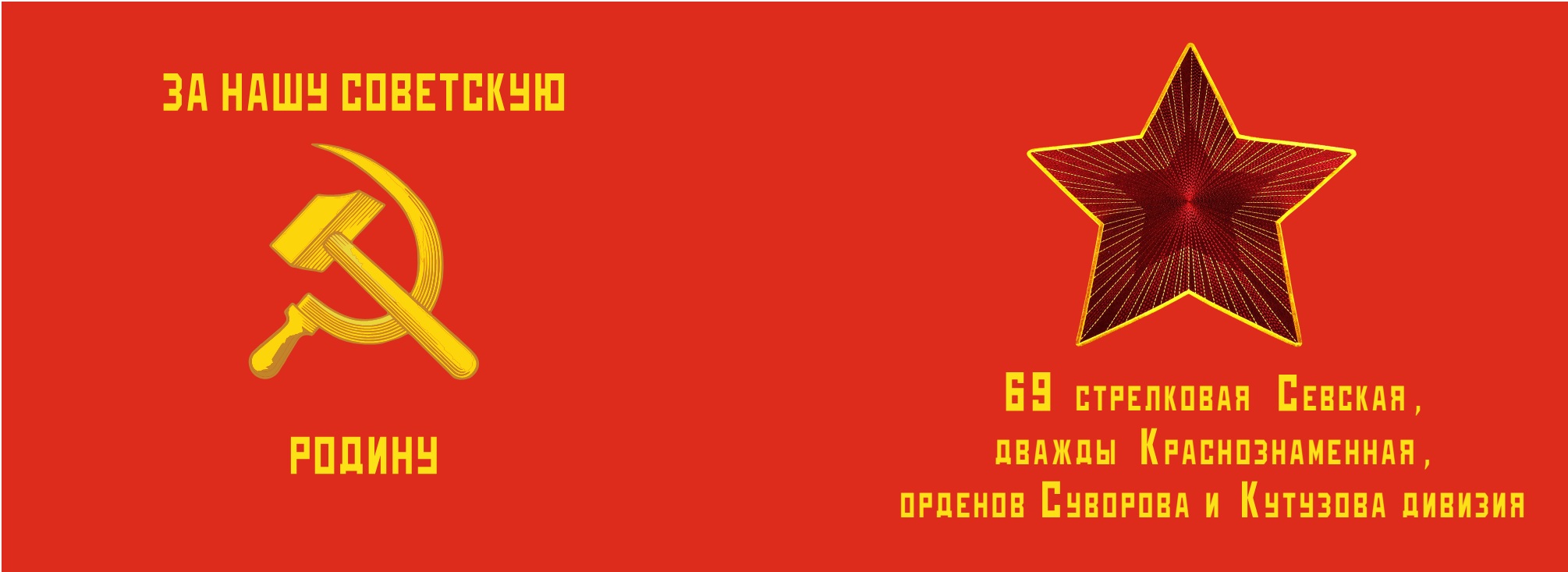
THE BATTLE FLAG
OF THE 69TH RIFLE OF WHICH WAS AWARDED TWICE RED BANNERED SEVSKY, ORDERS OF SUVOROV AND KUTUZOV DIVISION
The division was formed on December 22, 1941 in Tashkent and Chirchik as the 461st Rifle Division from among the military men of the Tashkent, Ferghana, Alma-Ata military commissariats.
On January 7, 1942 it was renamed as the 69th Infantry Division.
In the army during World War II from April 1, 1942 to February 04, 1943 and from February 18, 1943 to May 09, 1945.
The division was relocated from Tashkent to Bobrov (Volga Military District) from February 15 to February 20, 1942, and then was in Tula in March 1942.
From April 1942 until January 1943, the division conducted defensive battles in the Smolensk region. During the defense, more than 3 thousand fascist soldiers and officers were killed, 100 pillboxes and 30 dugouts were destroyed, and two depots with ammunition were blown up.
In early February 1943, the division was transferred to the area of the city of Livny, Oryol Oblast.
In the first half of 1943, it fought fierce battles on the Kursk Bulge.
On August 26, 1943, on the first day of the offensive it crossed the river Sev, captured 40 warehouses with ammunition and military equipment, and occupied half of the village of Novo-Yamskoye.
On August 27, 1943, together with the 103rd Tank Brigade, it liberated the city of Sevsk, continued the offensive and participated in the liberation of Khutor-Mikhailovsky (Friendship), Shostka, Novgorod-Seversky.
On September 07, 1943, with attacks it crossed the Desna.
Until September 13, 1943, it fought to expand the bridgehead in the direction of Sverdlovka, Kudlaevka.
From September 29 to September 30, 1943, it crossed the Sozh River.
On October 15, 1943, it crossed the Dnieper, and captured a bridgehead with an area of about 40 square kilometers on the western bank of the river. Having firmly fixed on it, division ensured the crossing to the right bank of the corps and other army units. It fought on the bridgehead until the end of November 1943.
In early 1944, the division participated in the January Kalinkovich-Mozyr operation.
On June 23-29, 1944, the division participated in the Bobruisk operation. It conducted heavy battles with erupting enemy units in the Osipovichi area, the division captured 3186 German soldiers and officers.
The division participated in the liberation of the Baranavichy region, crossed the Shchara River, and advanced faster than other divisions during the offensive. The cavalry squadron went to the state border of the Soviet Union and hoisted a red flag on it, immediately crossed the Western Bug. From September 5, 1944 to January 1945, units of the division fought on the Narevsky bridgehead.
From the bridgehead it attacked during the East Prussian operation, by the end of January it reached the approaches to Grudziadz, fighting the Wisla with battles at the end of January 1945, and on March 28, 1945 broke into Danzig with battles.
It took part in the Berlin strategic operation, forced the Ost-Oder and West-Oder rivers, and fought for the Stettin. It finished the hostilities in Rostock on May 02, 1945.
During the war, the division liberated more than 5,000 settlements. Over 17,000 soldiers and compound commanders during the war years were awarded orders and medals, 52 became Heroes of the Soviet Union. On the banners of the regiments of the division are 14 military orders.
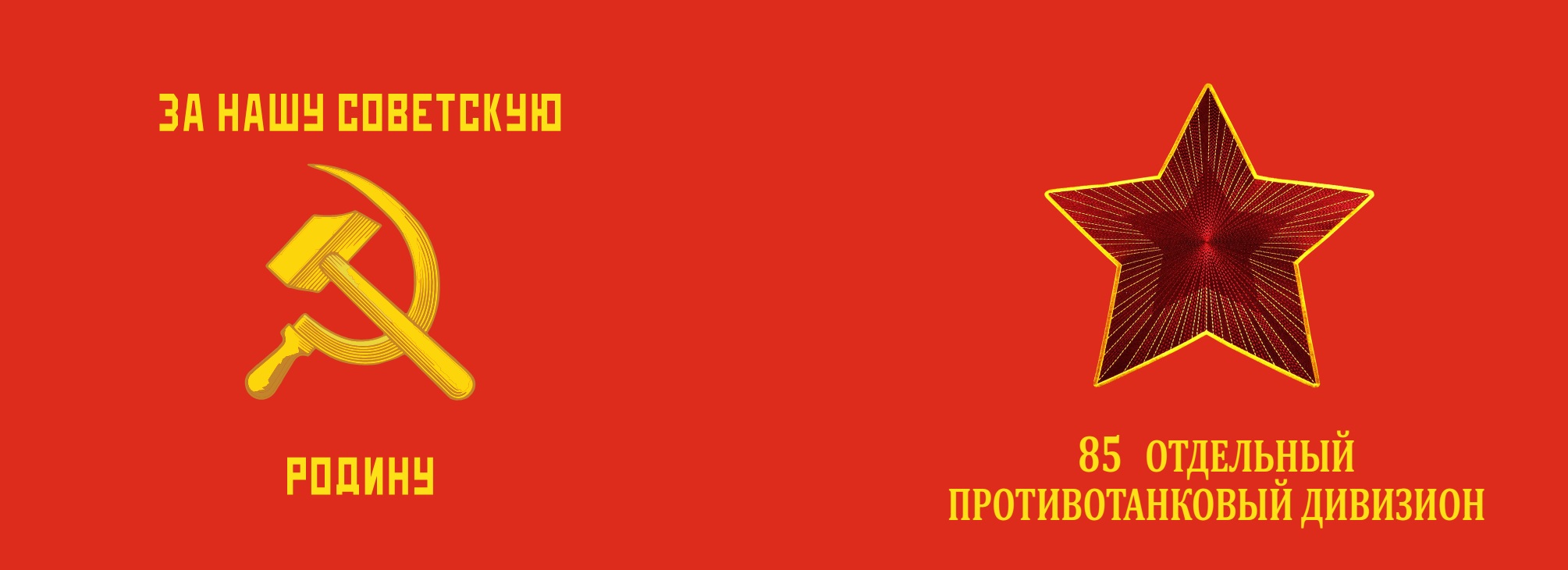
THE BATTLE FLAG
OF THE 85TH SEPARATE ANTI-TANK DIVISION
The 85th Separate Anti-Tank Division was part of the 162nd Central Asian Rifle Division
The anti-tank division of the 162nd Central Asian Rifle Division went a glorious battle path from Kursk to Berlin.
Unlimited courage and heroism in the battles showed many warriors.
During the offensive near Kursk, the 85th Separate Anti-Tank Division participated in the liberation of the cities of Oryol, Belgorod, Kharkov, Novgorod-Seversky, Sevsk and others.
Under the Battle Flag, the soldiers of the anti-tank division heroically fought in the battle for the Dnieper, in the liberation of Belarus, in the defeat of the fascist troops in Pomerania.
Under the command of Colonel S.Ya.Senchilo, Colonel Chernyak, Colonel A.O. Muratov, the 85th Separate Anti-Tank Division went the battle route from Kursk to the city of Rostock, from Bad Doberan to the shores of the Baltic Sea in Germany.
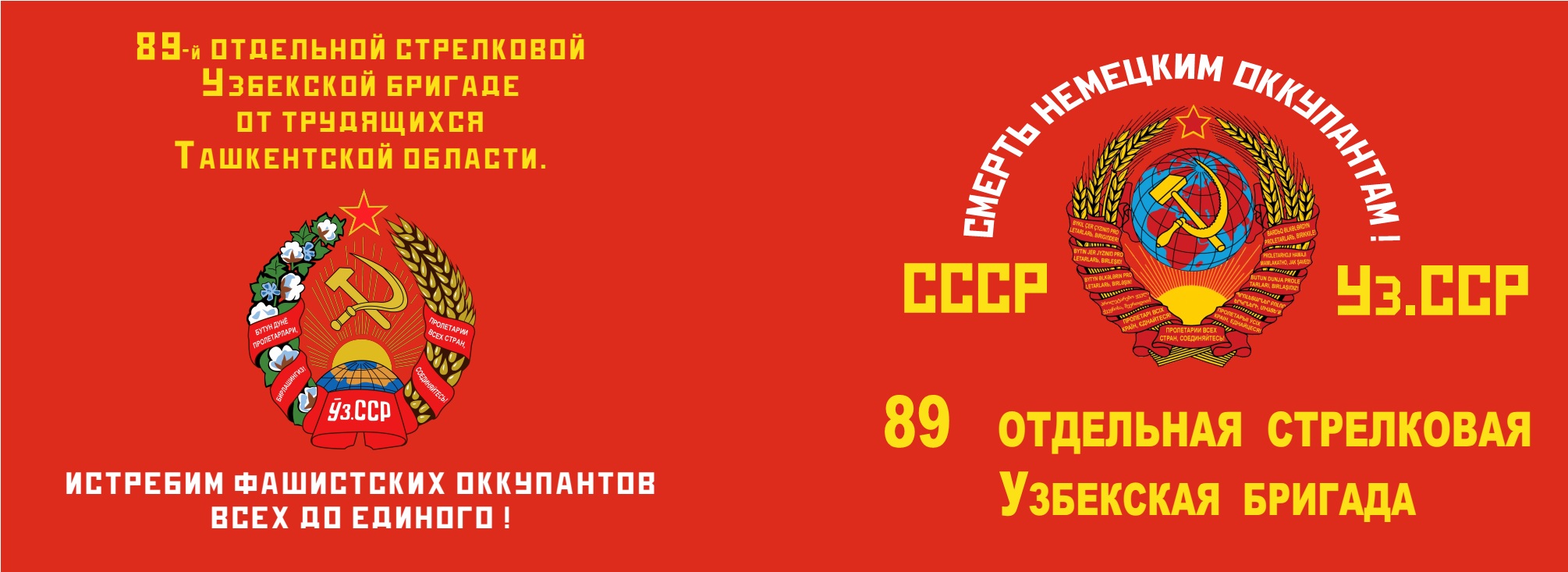
CHEF'S FLAG
THE 89TH SEPARATE INFANTRY BRIGADE
The 89th separate Infantry brigade was formed on the basis of the draft Resolution of the USSR State Defense Committee of November 13, 1941. No. 894 “On the Formation of National Troops in the Union and Autonomous Republics of the USSR”.
The formation is not completed due to lack of personnel. The personnel of the 89th Separate Infantry Brigade is focused on the acquisition of training and spare parts located on the front line.
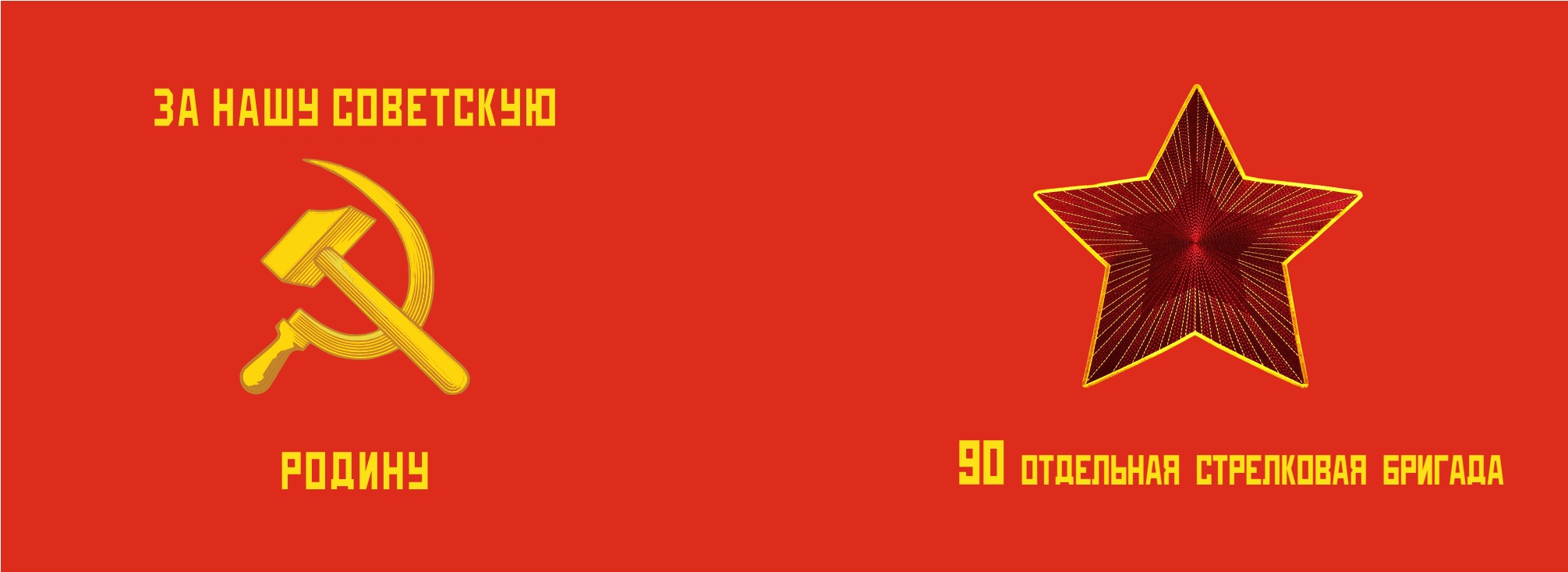
THE BATTLE FLAG
OF THE 90TH SEPARATE RIFLE BRIGADE
The 90th Separate Rifle Brigade was formed in the city of Samarqand in late 1941 and early 1942.
The brigade consisted of four separate infantry battalions, a separate communications battalion, an 82-mm division and a 120-mm mortar division, an anti-tank gun division, a reconnaissance company, a sapper company, a machine gun company, an ambulance company, and an auto-delivery company.
On August 18, 1942 it was relocated to the city of Babushkino for the defense of Moscow and became part of the 3rd Guards Army of the Moscow defense zone.
Since October 1942, as part of the 21st Army of the Stalingrad Front, it had participated in heavy and bloody defensive battles for the city of Stalingrad.
In November 1942, it participated in a breakthrough of enemy defenses on the Don River near the town of Serafimovich, it was surrounded, captured and liquidated by the Stalingrad group of German fascist troops of Field Marshal Paulus.
Staff sergeant Temur Berdiev, since December 1942, being in the post of commander of the 2nd platoon, killed 40 Nazis without losing a single soldier. And our fellow countryman Razhab Rasulev personally destroyed 17 Nazis.
For military merits, T. Berdyev and R. Rasulev were presented to government awards.
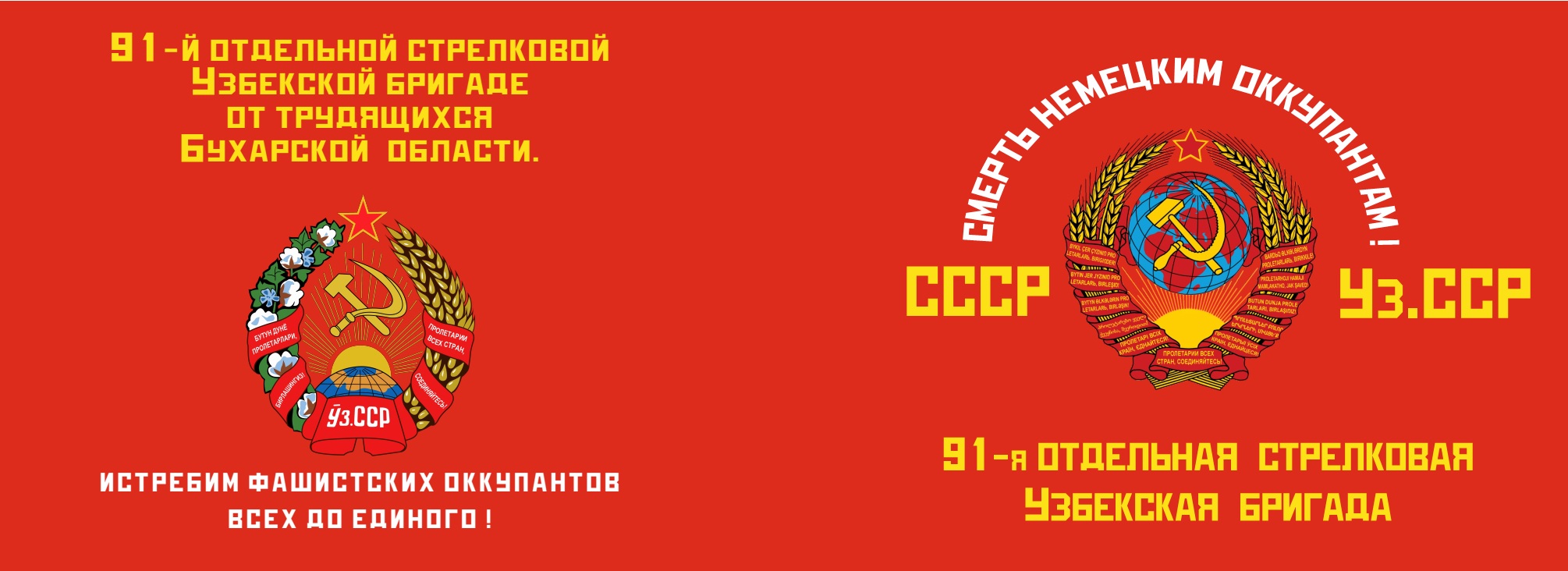
CHEF'S FLAG
THE 91ST SEPARATE INFANTRY BRIGADE
The 91st separate infantry brigade was formed on the basis of the draft Resolution of the USSR State Defense Committee of November 13, 1941. No. 894 “On the Formation of National Troops in the Union and Autonomous Republics of the USSR”.
The 91st separate infantry brigade was manned from December 1941 to March 1942 due to the personnel of the Central Asian military district and the initial composition of the reserve of the Khorezm regional military registration and enlistment office.
The acquisition area is Khorezm region. The brigade was located in three areas: Karakul, Sverdlovsk and Rometansky.
The brigade commander is Major Nasibulin.
Initial composition: Russians - 159, Uzbeks - 132, Ukrainians - 32.
The personnel of the 91st separate infantry brigade turned to the acquisition of training and spare parts.
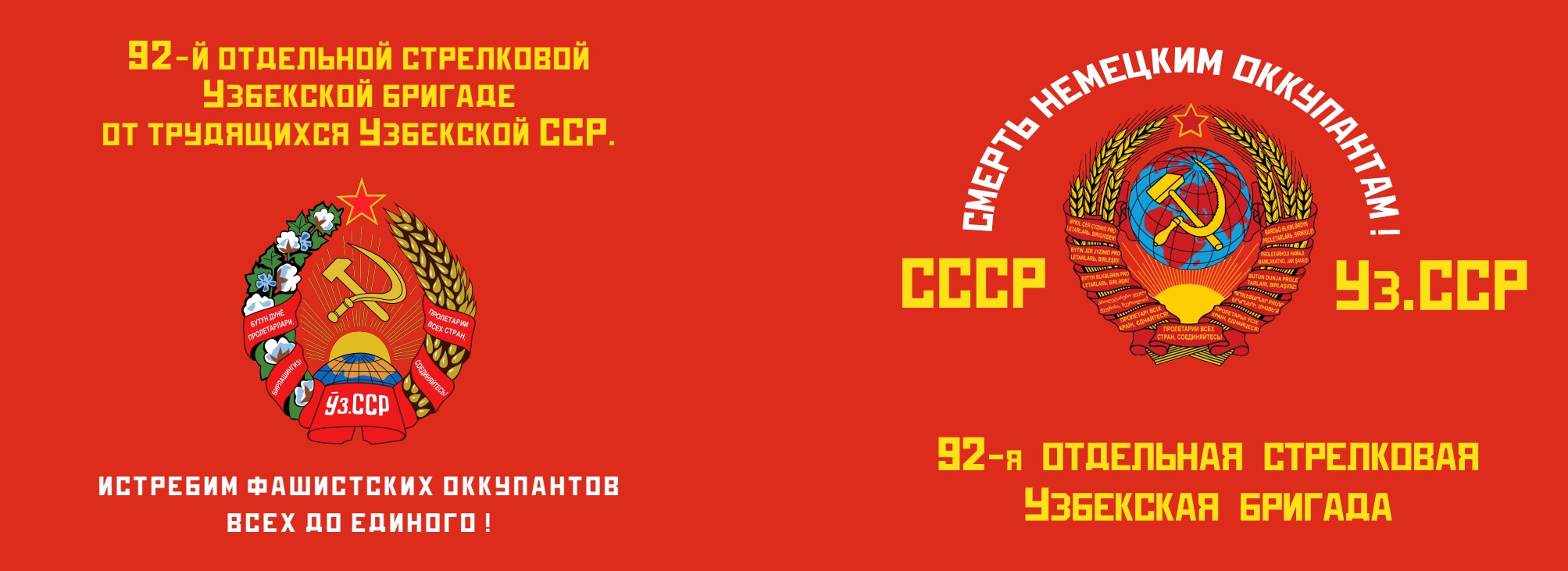
CHEF'S FLAG
THE 92TH SEPARATE INFANTRY BRIGADE
The 92th separate Infantry brigade was formed on the basis of the draft Resolution of the USSR State Defense Committee of November 13, 1941. No. 894 “On the Formation of National Troops in the Union and Autonomous Republics of the USSR”.
The formation is not completed due to lack of personnel. The personnel of the 92th Separate Infantry Brigade is focused on the acquisition of training and spare parts located on the front line.
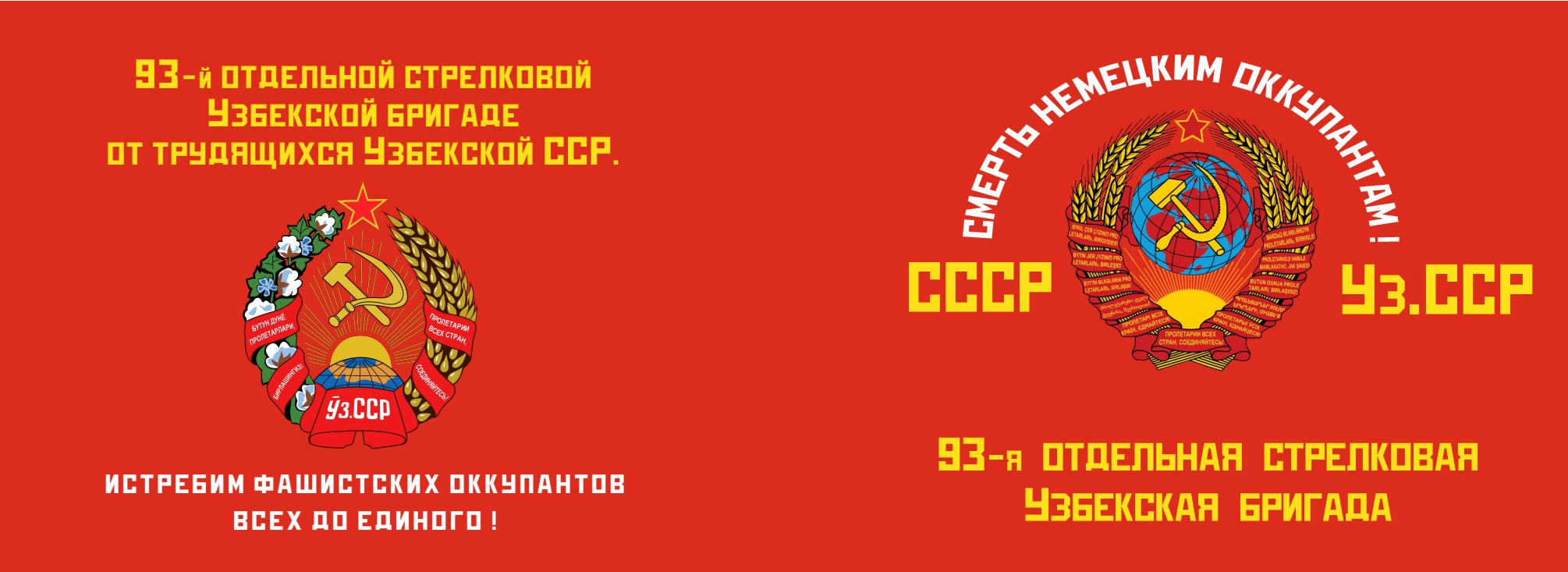
CHEF'S FLAG
THE 93TH SEPARATE INFANTRY BRIGADE
The 93th separate Infantry brigade was formed on the basis of the draft Resolution of the USSR State Defense Committee of November 13, 1941. No. 894 “On the Formation of National Troops in the Union and Autonomous Republics of the USSR”.
The formation is not completed due to lack of personnel. The personnel of the 93th Separate Infantry Brigade is focused on the acquisition of training and spare parts located on the front line.
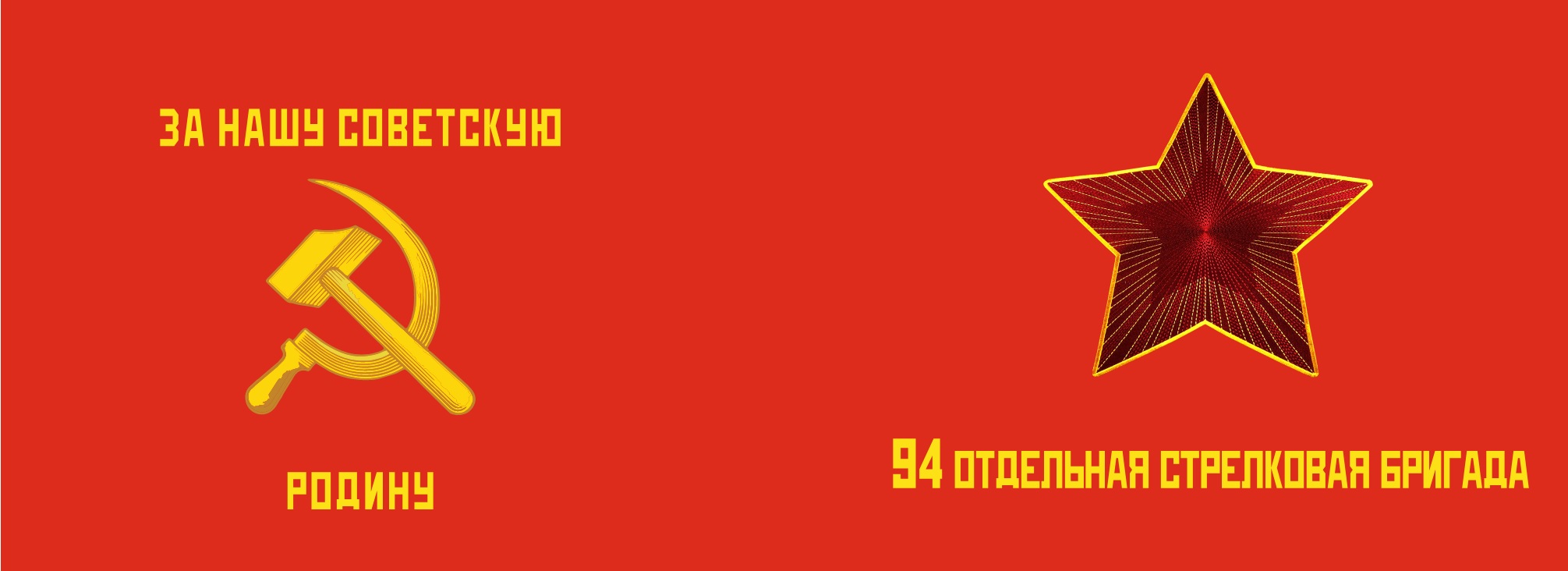
THE BATTLE FLAG
OF THE 94TH SEPARATE RIFLE BRIGADE
The 94th Separate Rifle Brigade was formed in the city of Fergana in late 1941 and early 1942.
The brigade consisted of four separate infantry battalions, a separate communications battalion, an 82-mm division and a 120-mm mortar division, an anti-tank gun division, a reconnaissance company, a sapper company, a machine gun company, an ambulance company, and an auto-delivery company.
On August 18, 1942 it was relocated to the city of Babushkino for the defense of Moscow and became part of the 3rd Guards Army of the Moscow defense zone.
Since October 1942, as part of the 21st Army of the Stalingrad Front, it had participated in heavy and bloody defensive battles for the city of Stalingrad.
In November 1942, it participated in a breakthrough of enemy defenses on the Don River near the town of Serafimovich, it was surrounded, captured and liquidated by the Stalingrad group of German fascist troops of Field Marshal Paulus.
Since January 1941, Captain Sabir Sabirovich Akhundzhanov (1919-2012) served as a company commander in this brigade, and then as an officer in the headquarters of the brigade; later, he served as Lieutenant General and holder of many orders and medals. Future general Akhundjanov’s two older brothers died in the battles: Shukur Sabirovich (1912-1943) and Shakir Sabirovich (1915-1943).
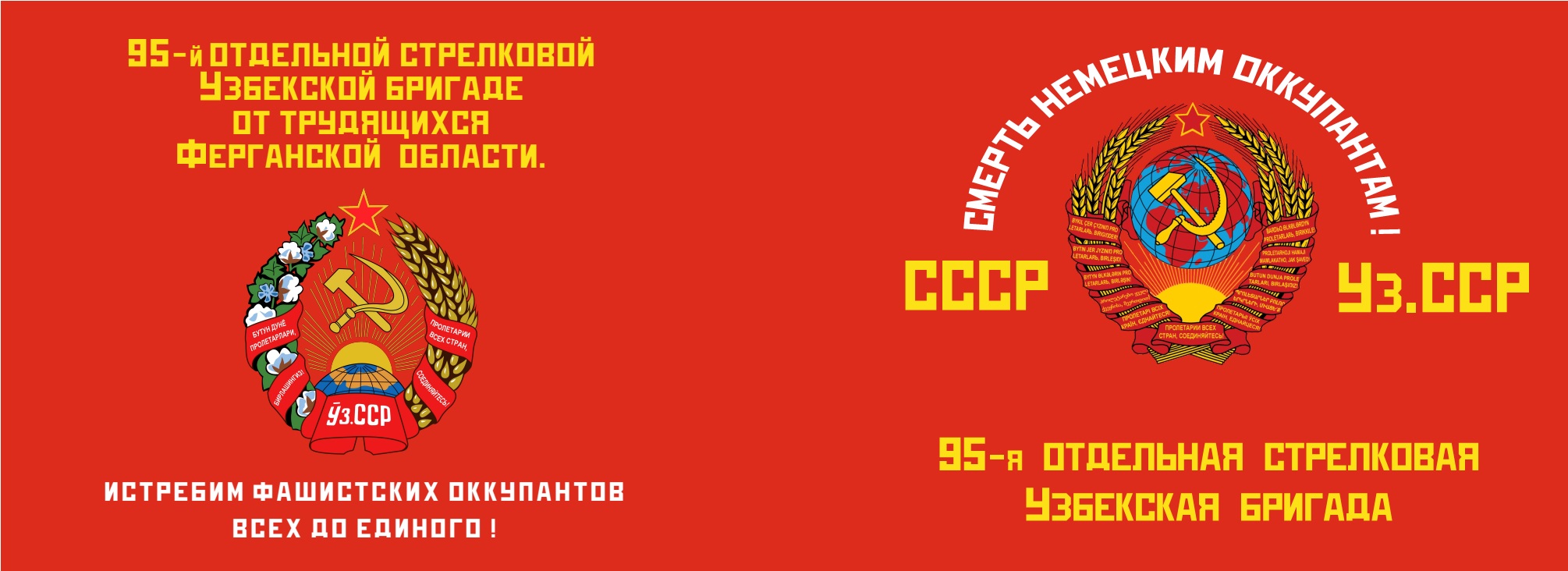
CHEF'S FLAG
THE 95TH SEPARATE INFANTRY BRIGADE
The 95th separate Infantry brigade was formed on the basis of the draft Resolution of the USSR State Defense Committee of November 13, 1941. No. 894 “On the Formation of National Troops in the Union and Autonomous Republics of the USSR”.
The formation is not completed due to lack of personnel. The personnel of the 95th Separate Infantry Brigade is focused on the acquisition of training and spare parts located on the front line.
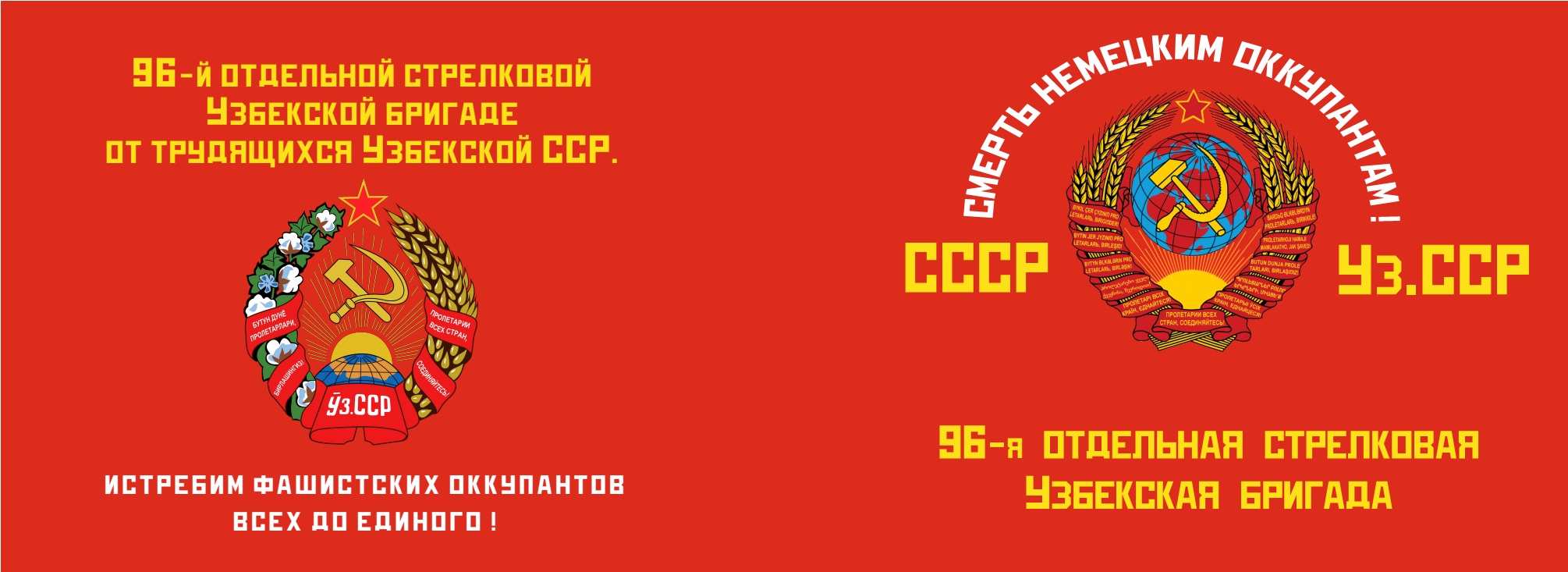
CHEF'S FLAG
THE 96TH SEPARATE INFANTRY BRIGADE
The 96th separate Infantry brigade was formed on the basis of the draft Resolution of the USSR State Defense Committee of November 13, 1941. No. 894 “On the Formation of National Troops in the Union and Autonomous Republics of the USSR”.
The formation is not completed due to lack of personnel. The personnel of the 96th Separate Infantry Brigade is focused on the acquisition of training and spare parts located on the front line.
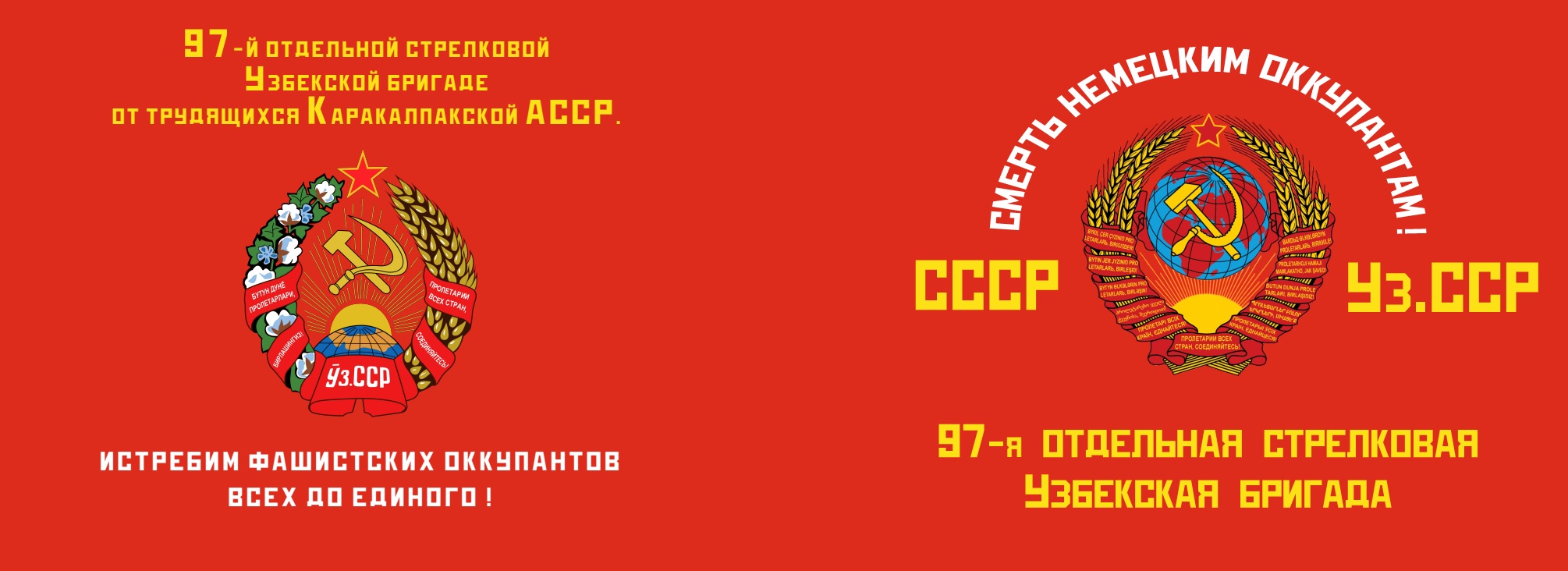
CHEF'S FLAG
THE 97TH SEPARATE INFANTRY BRIGADE
The 97th separate Infantry brigade was formed on the basis of the draft Resolution of the USSR State Defense Committee of November 13, 1941. No. 894 “On the Formation of National Troops in the Union and Autonomous Republics of the USSR”.
The formation is not completed due to lack of personnel. The personnel of the 97th Separate Infantry Brigade is focused on the acquisition of training and spare parts located on the front line.
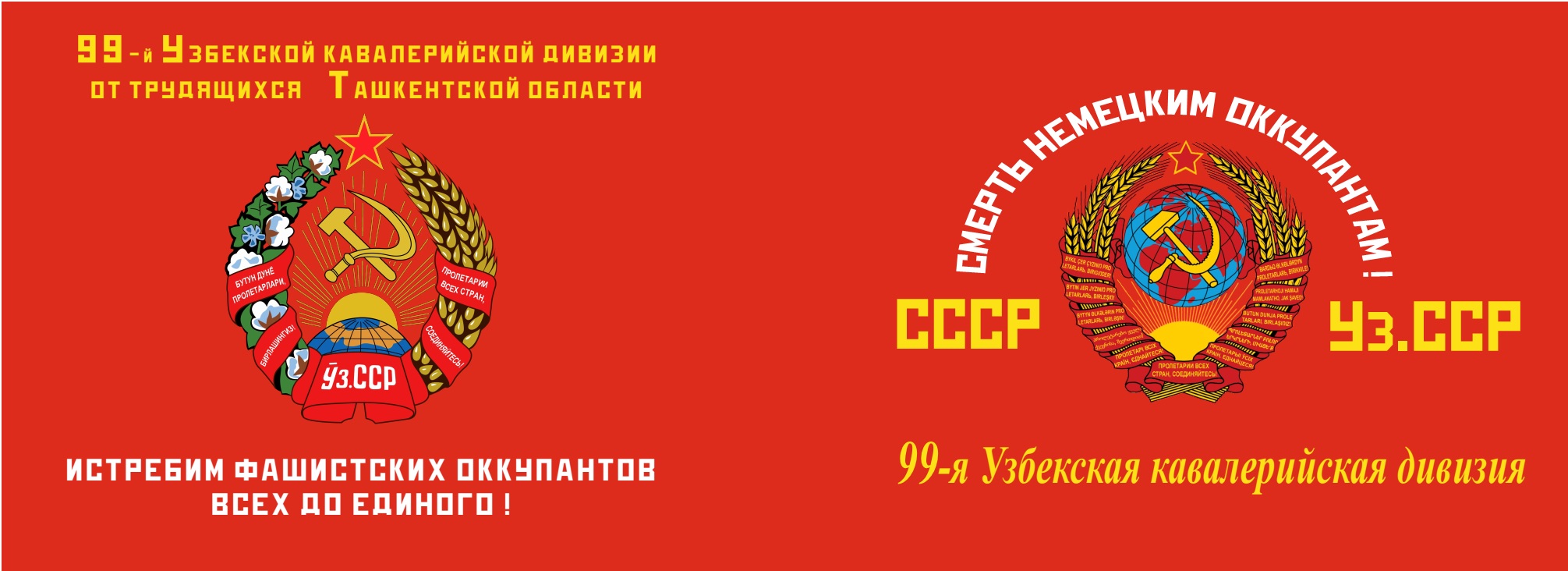
THE BATTLE FLAG
OF THE 99TH CAVALRY DIVISION
On October 14, 1941, the 99th Cavalry Division began to form in the Tashkent region.
In the formation of the 99th Cavalry Division, in particular the 381st Regiment, Abzalov Arif Abzalovich took an active part. The 381st Regiment was formed in the Yangiyul district. The regiment was commanded by Captain Maashrobov, then Major Krylov, the Commissar was Irgash Khabibov, and the Komsomol was Khasanov.
Colonel Pavlov was appointed commander of the 99th Cavalry Division, Major Mirzairov Ubaidulla was appointed commissar of the division, who was later replaced by battalion commissar Uzakov Mullazhan Karimovich, later major general. Its past glorious military path on the fronts was World War II.
The commanders of the squadrons were appointed Khudaiberdyev, Tashev, Sadykov, Gapurov, Hasanov, who subsequently heroically died in battles on the battlefields.
The 99th Cavalry Division underwent excellent combat training in the Yangiyul and Verkhny-Chirchik regions. Then the division went to the front. Subsequently, the 99th Cavalry Division was disbanded and parts of the division became part of the 333rd Guards Rifle Division.
The 333rd Infantry Division distinguished itself in the battles for Stalingrad, where the sons and daughters of Uzbekistan courageously fought.
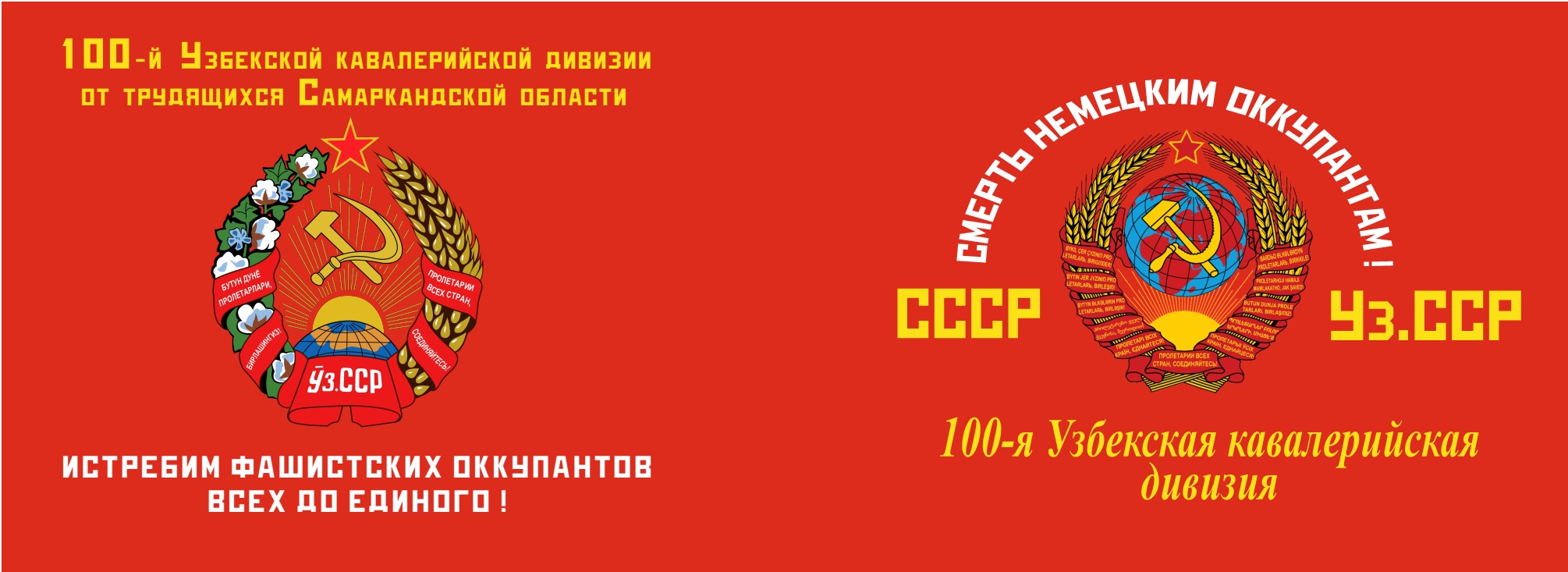
CHEF'S FLAG
THE 100TH CAVALRY DIVISION
The 100th Cavalry Division was formed on the basis of the draft Decree of the State Defense Committee of the USSR of November 13, 1941. No. 894 “On the Formation of National Troops in the Union and Autonomous Republics of the USSR”.
The formation is not completed due to lack of personnel. The personnel of the 100th Cavalry Division is assigned to the acquisition of training and spare parts located on the front line. The division was disbanded in June-July 1942.
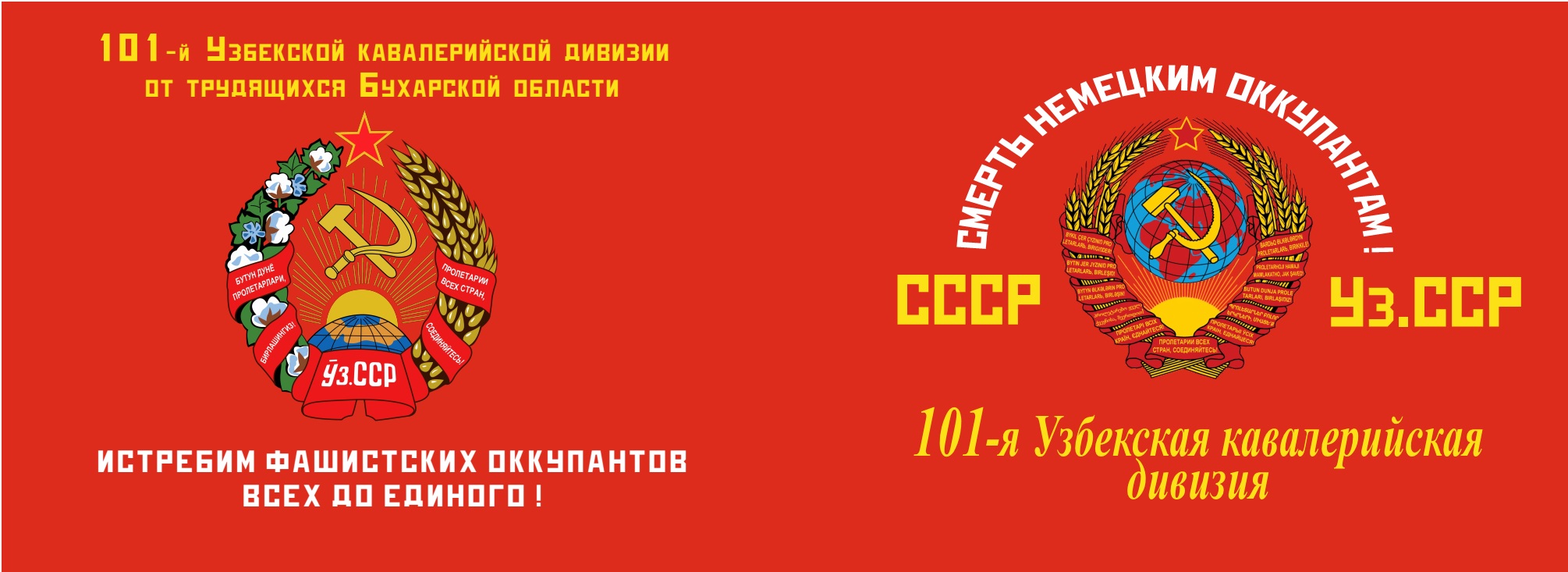
CHEF'S FLAG
THE 101TH CAVALRY DIVISION
The 101th Cavalry Division was formed on the basis of the draft Decree of the State Defense Committee of the USSR of November 13, 1941. No. 894 “On the Formation of National Troops in the Union and Autonomous Republics of the USSR”.
The formation is not completed due to lack of personnel. The personnel of the 101th Cavalry Division is assigned to the acquisition of training and spare parts located on the front line. The division was disbanded in June-July 1942.
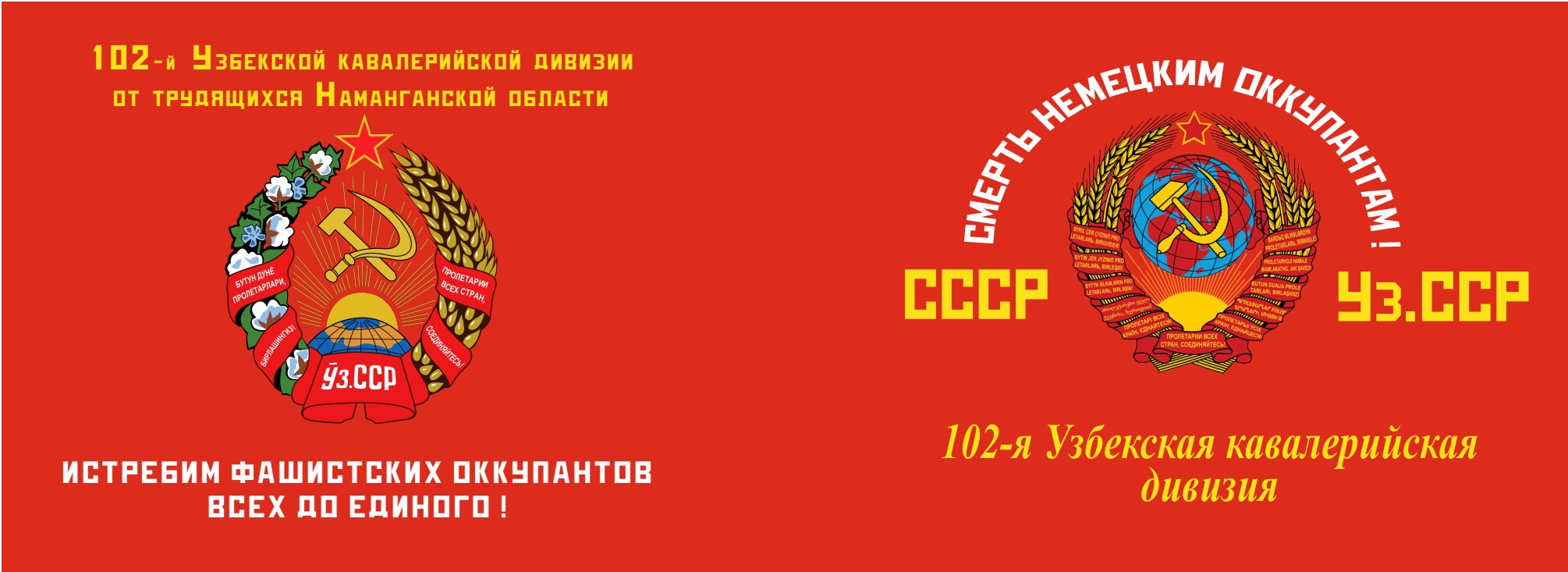
CHEF'S FLAG
THE 102TH CAVALRY DIVISION
The 102th Cavalry Division was formed on the basis of the draft Decree of the State Defense Committee of the USSR of November 13, 1941. No. 894 “On the Formation of National Troops in the Union and Autonomous Republics of the USSR”.
The formation is not completed due to lack of personnel. The personnel of the 102th Cavalry Division is assigned to the acquisition of training and spare parts located on the front line. The division was disbanded in June-July 1942.
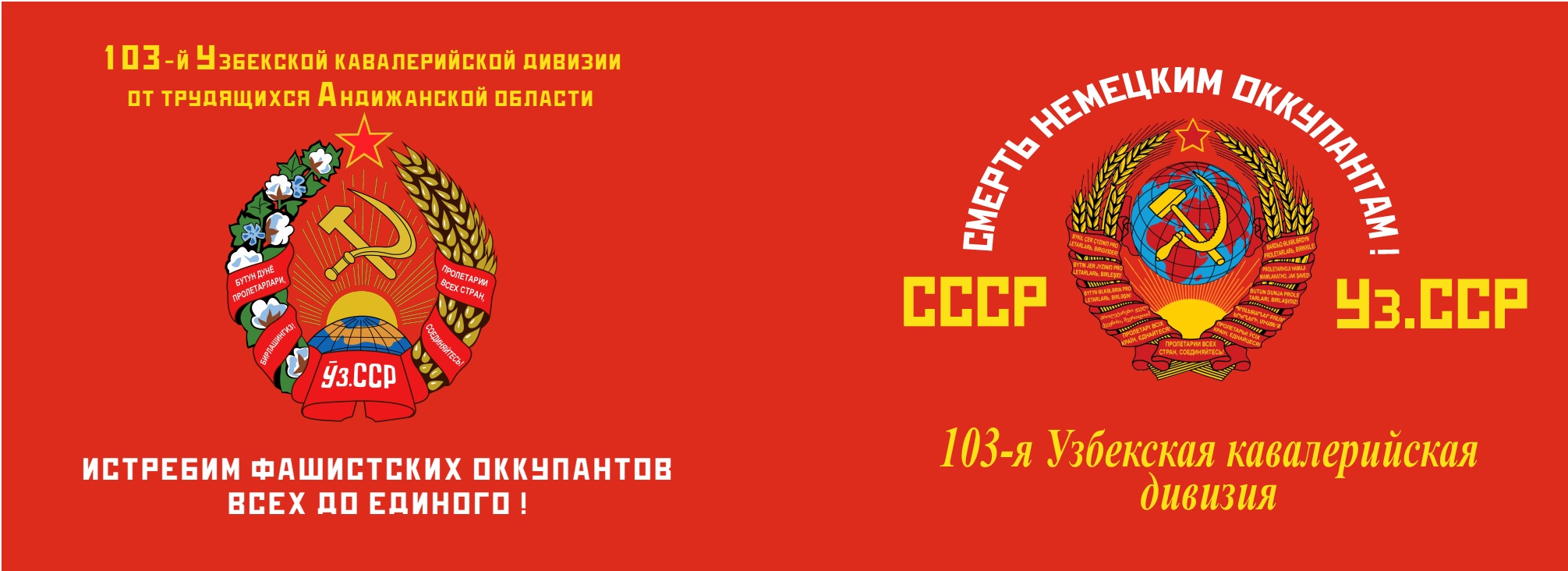
CHEF'S FLAG
THE 103TH CAVALRY DIVISION
The 103th Cavalry Division was formed on the basis of the draft Decree of the State Defense Committee of the USSR of November 13, 1941. No. 894 “On the Formation of National Troops in the Union and Autonomous Republics of the USSR”.
The formation is not completed due to lack of personnel. The personnel of the 103th Cavalry Division is assigned to the acquisition of training and spare parts located on the front line. The division was disbanded in June-July 1942.
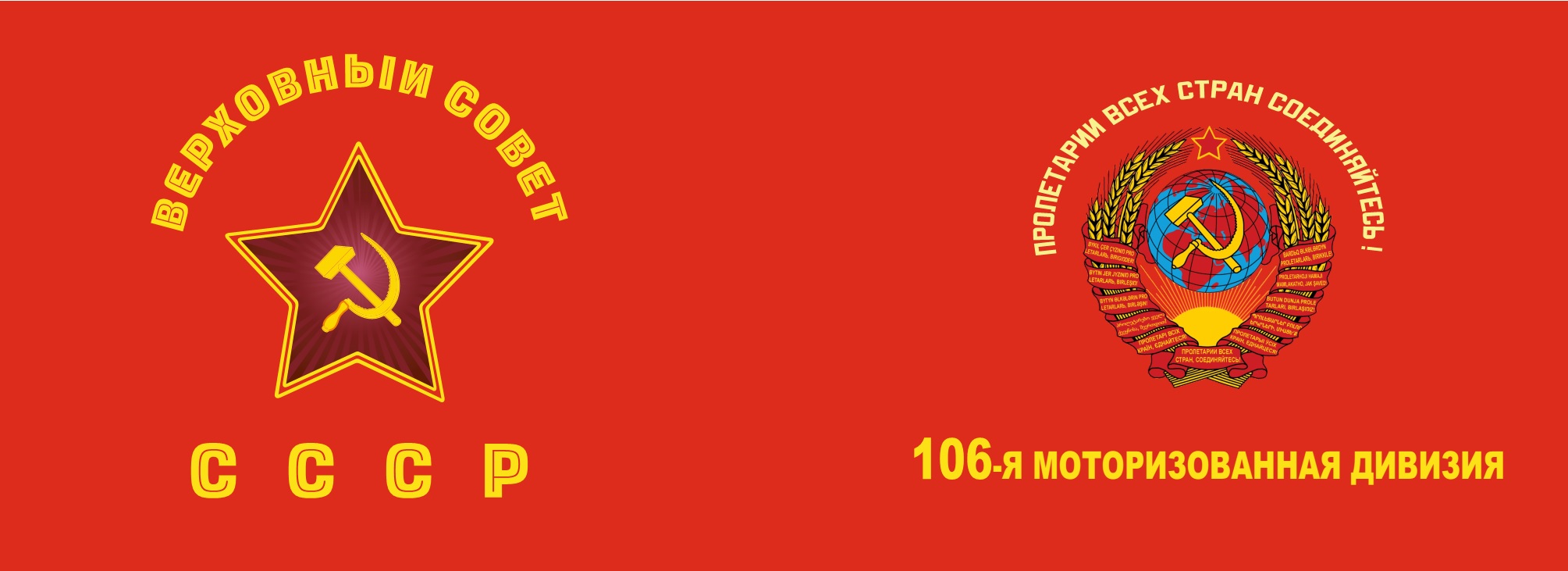
THE BATTLE FLAG
OF THE 106TH MOTORIZED DIVISION
It was formed on the basis of the 19th Uzbek GKD as the 221st Motorized Division in March 1941.
It reorganized from the 221st Motorized Division. It was originally planned to create a tank division with the same number in July 1941.
On July 18, 1941, the reorganization of the 221st Motorized Division into the 106th Panzer Division began, but then a decision was made to reorganize the division into the 106th Motorized Division.
July 18, it concentrated in the district of Spass-Demensk.
By July 22, the General Staff, the chiefs of the content departments, were obliged to fill the division with missing weapons, property and personnel.
On July 30 the Reserve Front formed. The 24th Army transferred to the Reserve Front. The division became part of the Reserve Front (front commander of the front, Army General G.K. Zhukov), which participated in the battle of Smolensk.
From July 23, it began participating in battles for the city of Yelnya. After fierce attacks on Yelnya, by July 31, the division occupied the line of Maltsevo, Malaya Lipnya, where the units put themselves in order.
From July 15 to July 29, the 24th Army, as part of the Front of the Reserve Armies, kept the line Bely, Dorogobuzh, Yelnya. During the battle of Smolensk, its troops inflicted two counterattacks: first, according to the grouping of German troops by enemy troops advancing from the area of Yelny on Dorogobuzh.
The division took part in the battles for Yelnya. On August 1, the division concentrated in the area of Maltsevo, Libya. On August 18, 1941, by order of the Chief of the General Staff of the Army General G.K. Zhukov, the division commander Colonel Alekseev was removed from the post of division commander. The former commander of the 158th SD Colonel Brynzov Vasily Petrovich was appointed commander of the 106th MD.
By August 30, the division numbered 5172 people.
Since September 28, 1941, the 106th Motorized Division was reorganized into the 106th Rifle Division of the Reserve Front (the 2nd formation).
Commanders:
Kuts Ivan Fedorovich, colonel
Alekseev (until 18.08.41), colonel
Brynzov Vasily Petrovich, colonel
Monakhov Konstantin Sergeevich (from 08.28.41), major
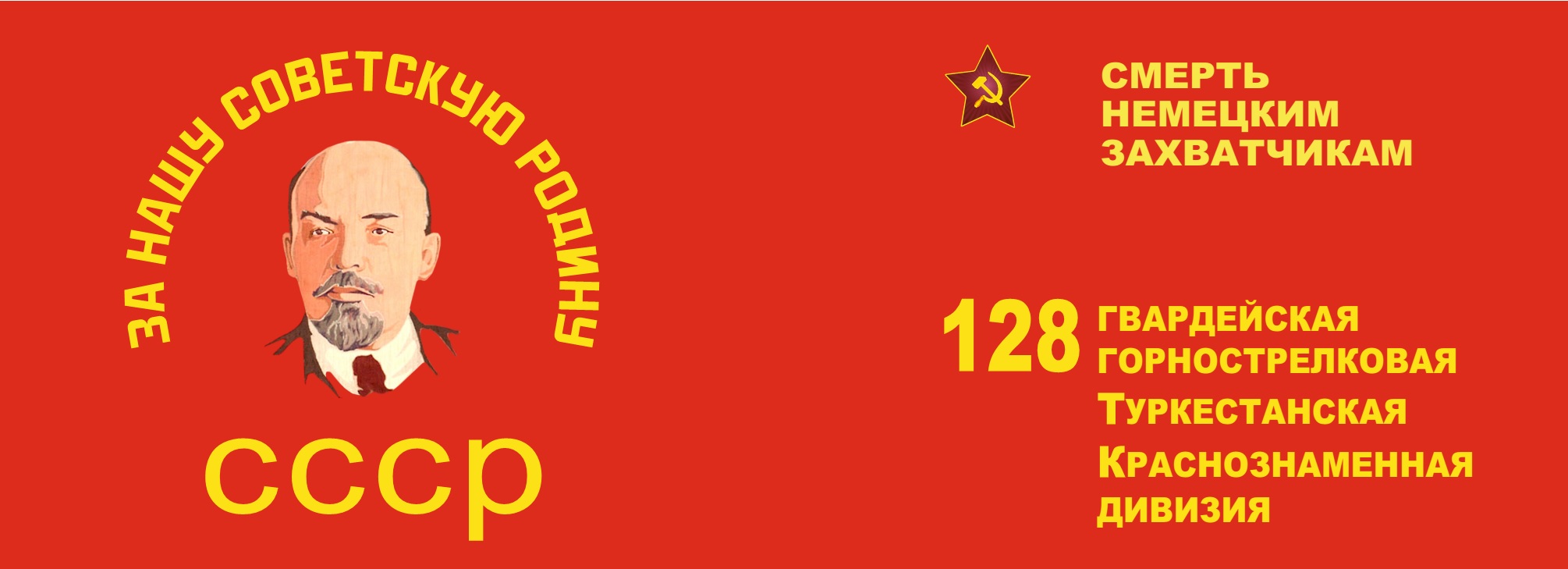
BATTLE FLAG
THE 128TH GUARDS MOUNTAIN RIFLE TURKESTAN RED BANNERED DIVISION
The original name was the 83rd Mountain Division.
In August 1941, it entered Iran as part of the 53rd Separate Central Asian Army. By order of the All-Russian High Commission in the autumn of 1942, it was transferred from the city of Mashhad to the Black Sea Group of Forces (18 A).
For valor and courage in liberating the Taman Peninsula, by order of the Supreme Court of October 9, 1943, it was transformed into the 128th Guards Turkestan Mountain Rifle Division.
In the spring of 1944, it participated in the offensive operation of the Separate Maritime Army.
For courage, heroism and military skill, the 128th Guards Turkestan Mountain Rifle Division and its 315th Guards Mountain Rifle Regiment were awarded the Order of the Red Banner.
323rd Guards Mountain Rifle Regiment was given the honorary name of Yalta.
327th Guards Mountain Rifle Regiment was awarded the honorary name of Sevastopol.
For the military distinction in the Carpathians in the autumn of 1944, the division was thanked by the High Command, and the 323rd Guards Mountain Rifle Red Bannered Yalta and 327th Guards Mountain Rifle Sevastopol Regiments were awarded the Order of Bogdan Khmelnitsky of 2nd degree, and 331st Guards Artillery Regiment was awarded the honorary name.
At the final stage of the war, the 128th Guards Turkestan Mountain Rifle Division as part of the 38th Army of the 4th Ukrainian Front participated in the liberation of Czechoslovakia.
During the war, the division received 12 thanks from the VG,
over 20 thousand soldiers of the division were awarded orders and medals,
7 of them awarded the title of “The Hero of the Soviet Union”,
19 became full holders of the Order of Glory.
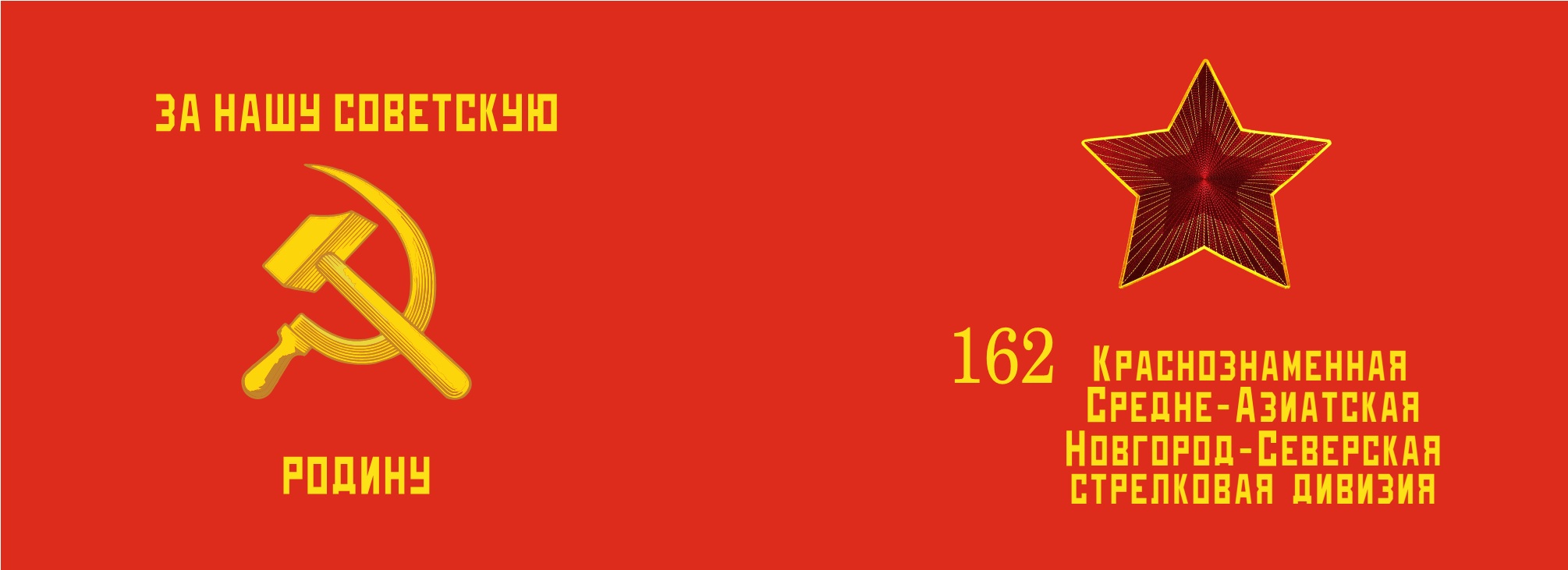
BATTLE FLAG
162ND RED BANNED CENTRAL ASIAN NOVGOROD - NORTHERN ORDER SUVOROV OF 2ND DEGREE
OF RIFLE DIVISION
In October - December 1942, 162 Central Asian Rifle Division was formed in Tashkent under the command of Colonel Senchilo S.Y. from parts of the border troops of the NKVD of Turkestan Military District. The personnel of the division were staffed mainly from the local population, border guards, graduates of the Tashkent Infantry School, officers of the Military Academies. The headquarters of the division was located in the building of the school of the border troops of the NKVD.
In December 1942, the division was redeployed to Zlatoust, where it was redeployed to Yelets as part of the 70th Separate Army.
The first baptism of fire received in winter offensive operations near Kursk in 1943 and participated in the historical battle “Kursk-Oryol Arc”. Colonel S.Y.Senchilo successfully directed the fighting of the division to the city of Rechitsa.
From October 1943 to January 1944, the division was commanded by Colonel Chernyak and marched with battles from Rechitsa to Brody.
From June 1944, from Brody to the German city of Bad-Daberan to the victorious hour of 1945, the division was brilliantly commanded by Colonel A.O.Muratov.
During the war years, the division as a part of the 65th, the 13th, the 70th Armies took part in the liberation of large cities like Dmitrov - Orlovsk, Sevsk, Novgorod - Seversky, Mozyr, Loev, Rechitsa, Kalinkovich, Hoop, Rivne, Brody, Rava - Russian, Sandomierz, Warsaw, Modlin, Thorn, Chojnice, Tuchol, Danzig, Schwedt, Bad-Daberan and others.
On November 18, 1943, for the successful conduct of military operations to capture the city of Rechitsa, the division was awarded the Order of the Red Banner.
It forced major rivers: Dina, Dnieper, Sozh, Vistula, Oder and others.
The soldiers of the division, during the liberation of the city of Novgorod - Seversky and forcing the Desna River, showed massive heroism and courage, for which the division was awarded the Order of Suvorov of 2nd degree and took the honorary name of “Novgorod – Seversky”. Many soldiers were awarded the title of “The Hero of the Soviet Union”, thousands of soldiers were awarded government awards. The Supreme Commander thanked to the troops participating in these battles. In Moscow, salute was given by 20 artillery volleys of 224 guns.
The division under the command of border guard S.Y.Senchilo, Colonel Chernyak, Colonel A.O.Muratov went the military way from Kursk to the city of Rostock, from Bad Doberan to the shores of the Baltic Sea in Germany.
The soldiers of the division contributed to the approach of the bright Victory Day in World War II in 1941–1945.
The division included:
The 224th Pamir Rifle Regiment;
The 209th Zaysan Rifle Regiment;
The 194th Tashkent Rifle Regiment;
The 369th Ashgabat Artillery Regiment;
The 85th Artillery Division;
The 79th Medical-Sanitary Battalion.
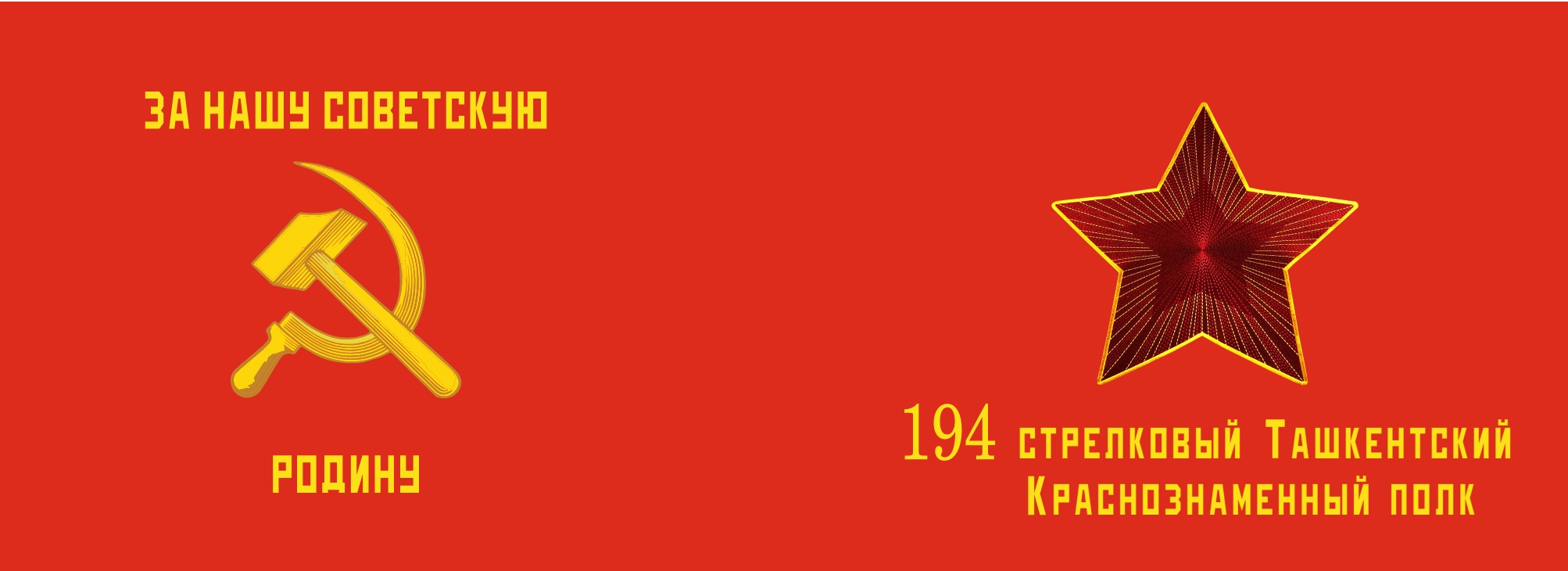
THE BATTLE FLAG
OF THE 194TH TASHKENT RED BANNERED RIFLE REGIMENT
The 194th Tashkent Red Bannered Rifle Regiment was part of the 162nd Rifle Division, formed in Tashkent from the border units of the Central Asian Military District in 1942.
The regiment as part of the division went the battle path from Kursk to Stettin.
The banner was fanned with the glory of victories in the battles on the Kursk Bulge, for the liberation of Novgorod-Seversky, between the Soy-Dnieper interfluves, the liberation of Belarus, the defeat of the fascist troops in Pomerania.
After the formation in Tashkent, the division left for the Urals. In conditions close to combat, for three months, fighters learned to fight, mastered new weapons, equestrians became mortars, gunners became gunners, armor-pierces, machine gunners.
Tashkent residents received their first baptism of fire near Dniester-Oryol. Off-road, they made a three-hundred-kilometer march, entered the battle right away, showed good training, solidarity and good discipline in it.
After short spring battles, the division strengthened on the Kursk ledge. As part of the troops of the 70th army, it led into hostilities in the northwestern part of the Kursk ledge.
A glorious page in the history of the 162nd division included the feat of 18 heroes of the Tashkent regiment. It covered the right flank of the unit from advancing on the village Samodurovka Nazis and Warm. 18 fighters led by platoon commander Lieutenant A. D. Romanovsky settled down at a low altitude. Up to 200 German machine gunners rushed to this height. An unequal battle broke out. The warriors repelled the attack with friendly fire, but the Germans did not relent. They attacked again. The battle did not weaken for a minute, it turned into hand-to-hand combat. Almost all fighters were injured. Sergeant Grigory Gaydamatchenko was wounded in the shoulder with an enemy bullet. Hastily making a dressing, he continued to fight. Over 80 corpses of the Nazis dotted the approaches to the defense of Romanovsky. Strengthening the forces, the Nazis again attacked the soldiers, but they did not flinch. The soldiers died, but did not let the enemy pass through their line. The glorious heroes of the Tashkent regiment actually repeated the feat of the Panfilovites near Moscow. The entire platoon personnel were posthumously awarded the Order of the “World War of the 1st degree”.
On its way, the division crossed many water lines. It was especially distinguished in the battles for the liberation of the city of Novgorod-Seversky, for which it received the name Novgorod-Seversky Division.
For crossing the Dnieper, the division was awarded the Order of Suvorov of the 2nd degree.
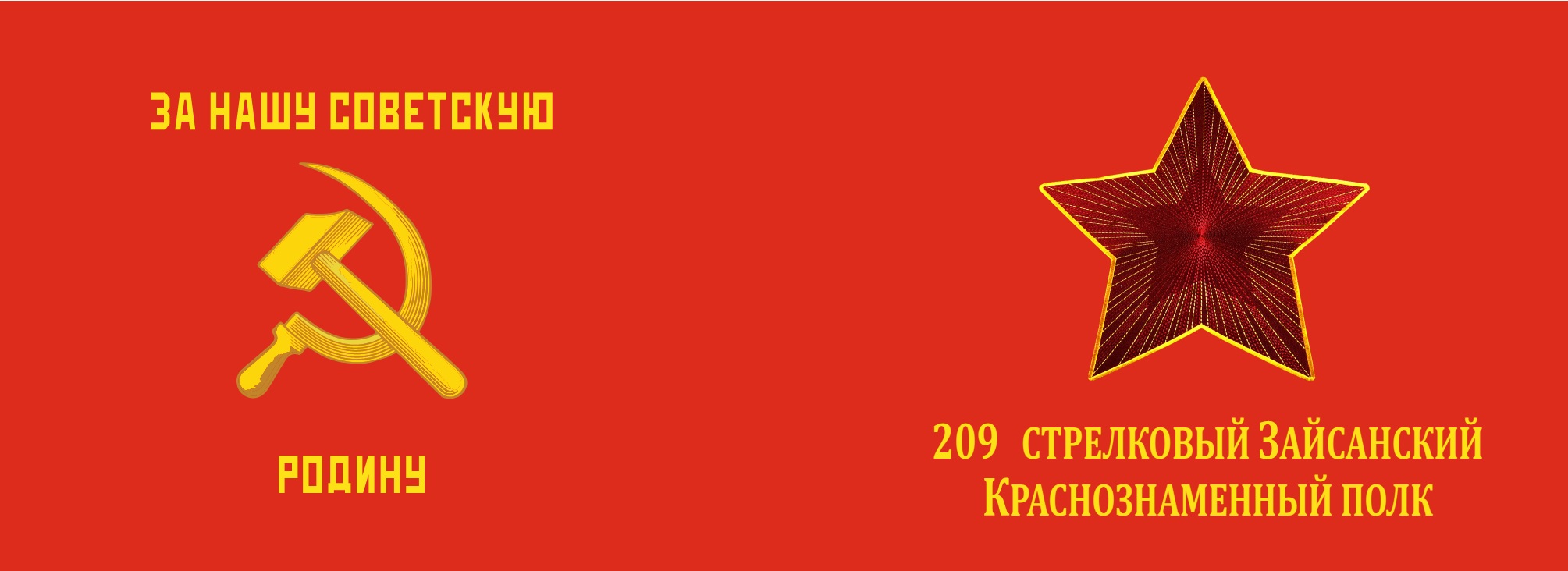
THE BATTLE FLAG
OF THE 209TH RIFLE ZAISAN RED BANNERED REGIMENT
The 209th Zaisan Red Bannered Regiment was part of the 162nd Red Bannered Central Asian Novgorod – Seversky, which owner of the order of Suvorov of the 2nd degree of the rifle division, which was formed from parts of the border troops of the NKVD of the Turkestan Military District from October to December 1942, in Tashkent. Colonel S.Y. Senchilo was appointed commander of the division.
The staff of the regiment was mainly staffed by residents of Uzbekistan, border guards, graduates of the Tashkent Infantry School, and officers of the Military Academies. The headquarters of the division was located in the building of the school of the border troops of the NKVD.
In December 1942, the division was redeployed to Zlatoust. The gunsmiths of the city of Zlatoust made knives with black handles for each soldier of the division. Those knives were an identification mark of division warriors. The Nazis called it as “Black Knife Division”. The regiment as part of the 70th separate Army was relocated to the city of Yelets.
The regiment received its first baptism of fire in winter offensive operations near Kursk in 1943 and was participated in the historical battle “Kursk - Oryol Arc”.
From October 1943 to January 1944, the division was commanded by Colonel Chernyak and marched with battles from Rechitsa to Brody.
During the war years, the regiment took part in the liberation of large cities such as Dmitrov - Orlovsk, Sevsk, Novgorod - Seversky, Mazyr, Loev, Rechitsa, Kalinkovich, Hoop, Rivne, Brody, Rava - Russian, Sandomir, Warsaw, Modlin, Torn, Chojnice, Tukhol, Danzig, Schwedt, Bad Daberan and others.
It also participated in forcing large rivers: Dina, Dnieper, Sozh, Vistula, Oder and others.
The soldiers of the regiment, during the liberation of the city of Novgorod - Seversky and forcing the Desna River, showed massive heroism and courage, for which the division was awarded the order of Suvorov of the II degree and the honorary name “Novgorod – Seversky” was awarded. Many soldiers were awarded the title “The Hero of the Soviet Union”, and thousands of soldiers were awarded government awards. The Supreme Commander declared “Certificate of honor” to the troops who participated in these battles. In Moscow, salute was given by 20 artillery volleys of 224 guns.
The regiment as part of the 162nd Red Bannered Central Asian Novgorod – Seversky, owner of the order of Suvorov of the II degree of the infantry division under the command of Colonel S.Y. Senchilo, Colonel Chernyak, Colonel A.O. Muratov went the battle route from Kursk to the city of Rostock, from Bad - Doberan to the shores of the Baltic Sea in Germany.
The soldiers of the regiment, with their heroism and unlimited loyalty to the motherland, made a huge contribution to the approaching of the bright Victory Day in World War II of 1941–1945.
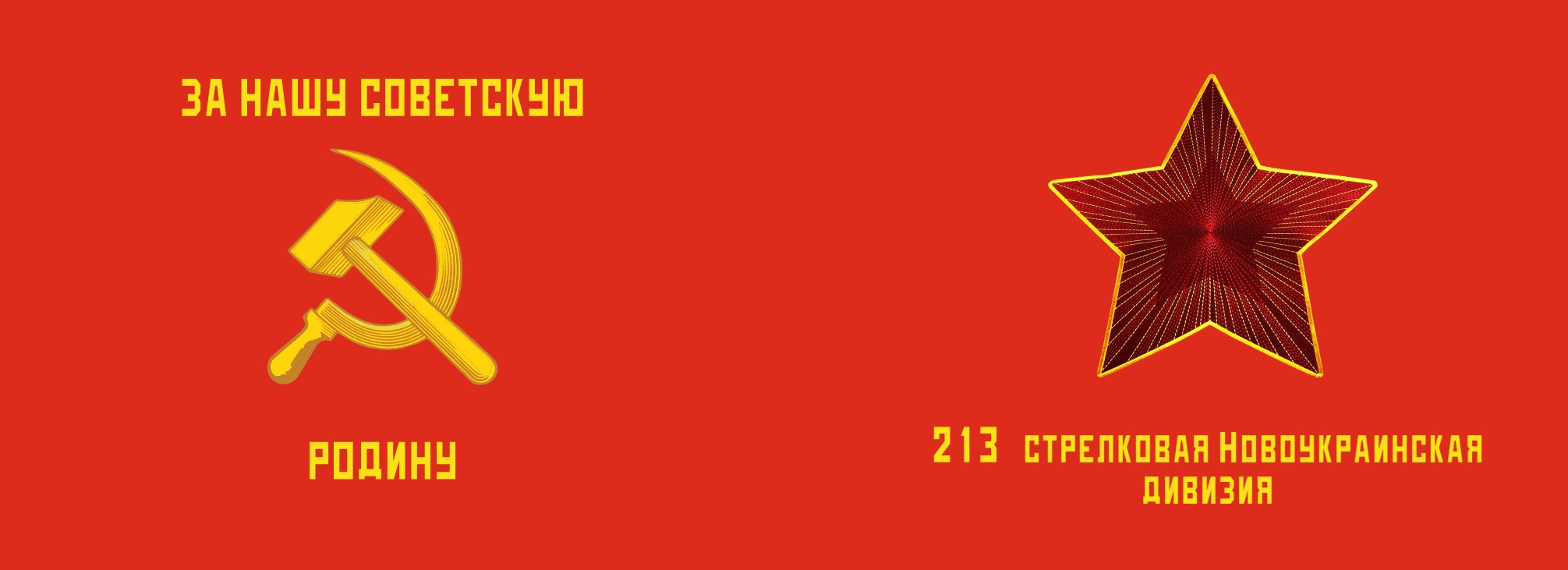
THE BATTLEFLAG
OF THE 213TH RIFLE NOVOUKRAINSKAYA DIVISION
The division was formed from October to December 1941, in the city of Kattakurgan of the Uzbek SSR with the draft contingent of the Uzbek Republican Military Commissariat. Until February 20, 1943, it was part of the Central Asian Military District (CAMD), where it was first housed in Kattakurgan, and then on the section of the border with Afghanistan between the cities of Kerki and Termez. From the moment of its formation until February 1943, the division conducted active training and sent more than 20,000 soldiers and officers to the front with marching companies.
On February 20, 1943, the division began to transfer its units to the front, arriving in full force on April 19, 1943 at Valuyki station, where it became part of the 64th Army of the Voronezh Front and occupied a defensive line along the eastern bank of the Seversky Donets River in the Mikhailovka-Nizhny Olshanets section. The division remained in those positions until May 17, 1943.
On May 18, 1943, the 213th Infantry Division was assigned to the reserve of the 7th Guards Army. Being in the army reserve until May 5, 1943, the division put its units in order and conducted combat training.
From September 26 to September 27, 1943, units of the 213th Infantry Division crossed the Dnieper on improvised crossing facilities. And then, until September 30, they fought hard stubborn battles for expanding the bridgehead on the right flank of the 7th Guards Army. For the successful crossing of the Dnieper and the expansion of the bridgehead by Decree of the Supreme Soviet of the USSR, 16 officers, sergeants and soldiers of the 213th Infantry Division were awarded the title of “The Hero of the Soviet Union”.
On October 20, 1944, the division of the 52nd Army became part of the 1st Ukrainian Front and was transferred to the Polish city of Nisko.
On December 23, 1944, the division, after a two-day march, concentrated in the area of Sandomierz bridgehead, where until January 10, 1945 it conducted military and political training of personnel.
As of January 1, 1945, the division consisted of 7115 people: officers were 824 people, sergeants were 1985 people, and privates were 4366 people.
By order of the Supreme Commander-in-Chief № 072 dated on March 29, 1944, to mark the victory achieved and the distinction in the battles to liberate the city of Novoukrainka, the division was given the honorary name Novoukrainskaya.
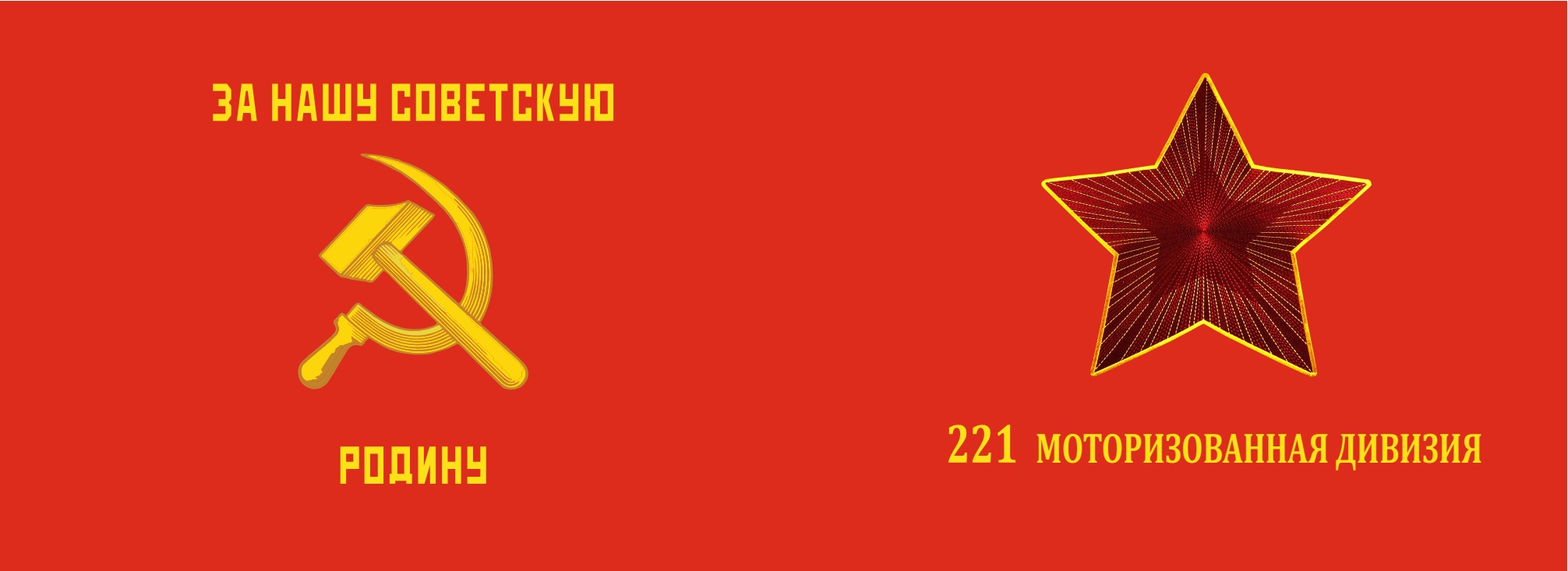
THE BATTLE FLAG
OF THE 221ST MOTORIZED DIVISION
The 221st Motorized Division was deployed in March 1941 on the basis of the 19th Uzbek Order of Lenin of the Mountain Cavalry Division in Samarkand. It had mostly well-trained personnel, but not very good cars mobilized from the national economy.
In March 1941, in the city of Mary (SAVO), the 27th Mechanized Corps began to form. It included the previously formed 221st Panzer Division. The corps was headed by Major General Ivan Yefimovich Petrov, who had previously been the commander of the Mountain Rifle Division and the head of the infantry school.
In March 1941, the 9th Division received an encryption of the three-month planning of combat training (through May inclusive). This period turned out to be the most stressful: tactical exercises combat firing, practicing the interaction of the units and their knocking together took place in all parts. By the summer of 1941, the 9th Panzer Division became one of the most combat-ready SAVO formations. This was confirmed by the command-and-staff exercise led by representatives of the General Staff M.N. Sharokhin and S.M. Shtemenko, held in the Mary region in the first half of 1941.
The peculiarity of the combat training of the divisions was that the tankers very often practiced at night because of the heat reaching 50-60 degrees. But the darkness caused another inconvenience; there was a danger of attack by poisonous scorpions and phalanges. Scorpion bite occurred regularly. A terrible test was the winds raising clouds of hot sand. After the sand storms, the tanks turned out to be covered up, and then they had to be dug out of the sand for a long time.
Despite the apparent weakness of the connection, on June 25, 1941 the headquarters of the Central Asian military district already received an order on the readiness of the 27th Mechanized Corps to begin redeployment to the west by July 4, 1941
Already on June 27, sending the first echelon to the west began, followed by the rest. On the morning of July 8, the head train was already approaching Voronezh. The trains began arriving at the Faience station on July 11; they were unloaded only at night, because German aviation dominated the sky. Many echelons moving across the country at a courier speed, when approaching the unloading areas, were delayed due to the destruction of the railway track and traffic jams on the routes.
On July 8, 1941, the General Staff decided to disband the corps link of the armored forces and reorganize the existing tank divisions into new states (217 vehicles in the tank division, anti-tank artillery regiment instead of gap). Reformation affected primarily those tank formations that were not involved in the fighting. To distinguish the divisions of the new states, they were assigned new numbers: starting with the 101st. In accordance with this decision, the 221st Motorized Division was transformed into the 106th Motorized Division. In the new division, until the second order, the second Motorized Rifle Regiment remained, and instead of the tank regiment, due to the lack of tanks, the 106th tank battalion was included.
Division Commander:
Roitenberg Gersh Moiseevich, colonel
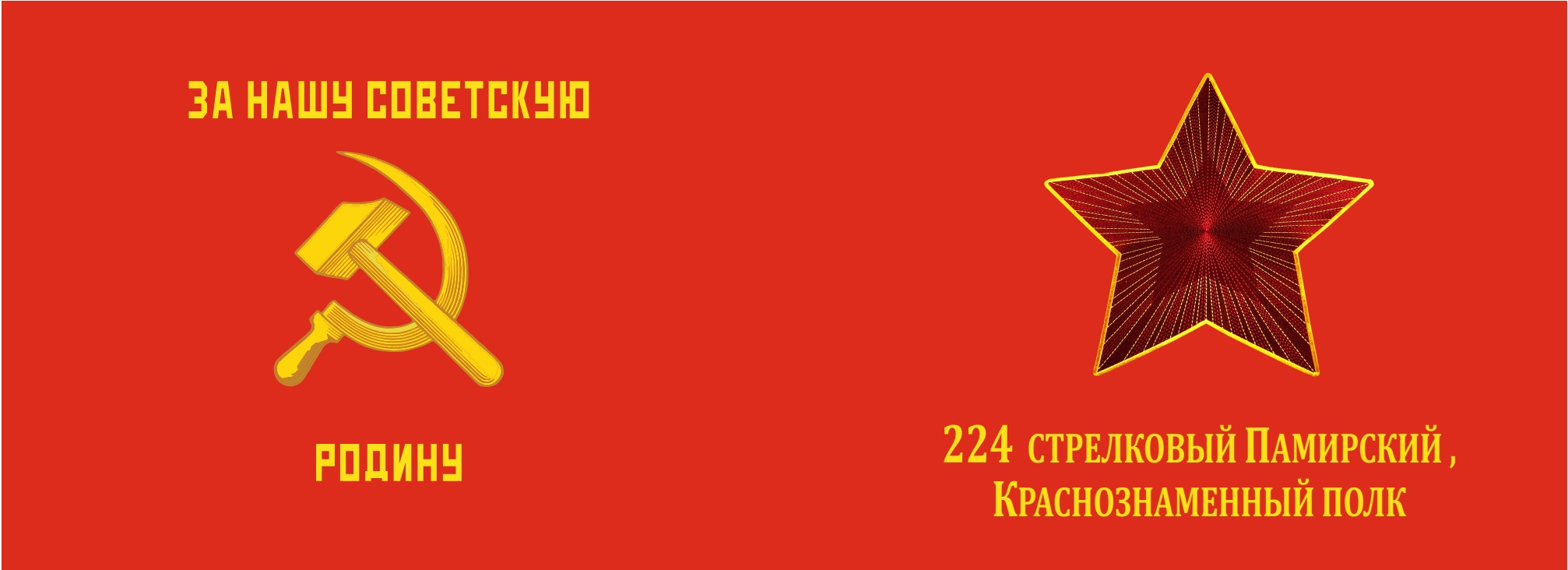
THE BATTLEFLAG
OF THE 224TH RIFLE OF THE PAMIR RED BANNERED REGIMENT
The 224th Rifle Pamir Red Bannered Regiment was part of the 162nd Central Asian Rifle Division.
The regiment as part of the 162nd Central Asian Rifle Division passed a glorious military path from Kursk to Berlin.
Unlimited courage and heroism in the battles showed many soldiers of the regiment.
Here are just a few episodes:
The calculation of the guns under the command of Abdullah Baimstanov heroically fought: machine gunners Alir Shagunov, Ilya Chirkov, tank destroyers Mikhail Tungusov, Mikhail Shipikhin. The calculation of Abdullah Baimstanov destroyed 4 tanks, 3 guns, 18 machine guns and 70 fascists. More than 100 fascist soldiers and 6 firing points were destroyed by machine gunner Ilya Chirkov.
For two hours, four scouts under the command of Senior Sergeant Vladimir Epifantsev fought in a house surrounded by fascists. The Nazis set fire to the house where the heroes were. But courageous scouts emerged victorious from an unequal battle, and destroyed 20 fascists.
During the offensive near Kursk, the regiment participated in the liberation of the cities of Oryol, Belgorod, Kharkov, Novgorod-Seversky, Sevsk and others.
Under the Battle Flag, the regiment heroically fought in the battle for the Dnieper, in the liberation of Belarus, in the defeat of the fascist troops in Pomerania.
For the braveness, heroism, courage, loyalty to the motherland and military duty shown by the regiment’s personnel in battles against the fascist invaders the 224th Rifle Pamir Red Bannered Regiment was awarded the Order of the Red Banner, the Order of “Suvorov” of the 3rd degree and the Order of “Alexander Nevsky” of the 3rd degree.
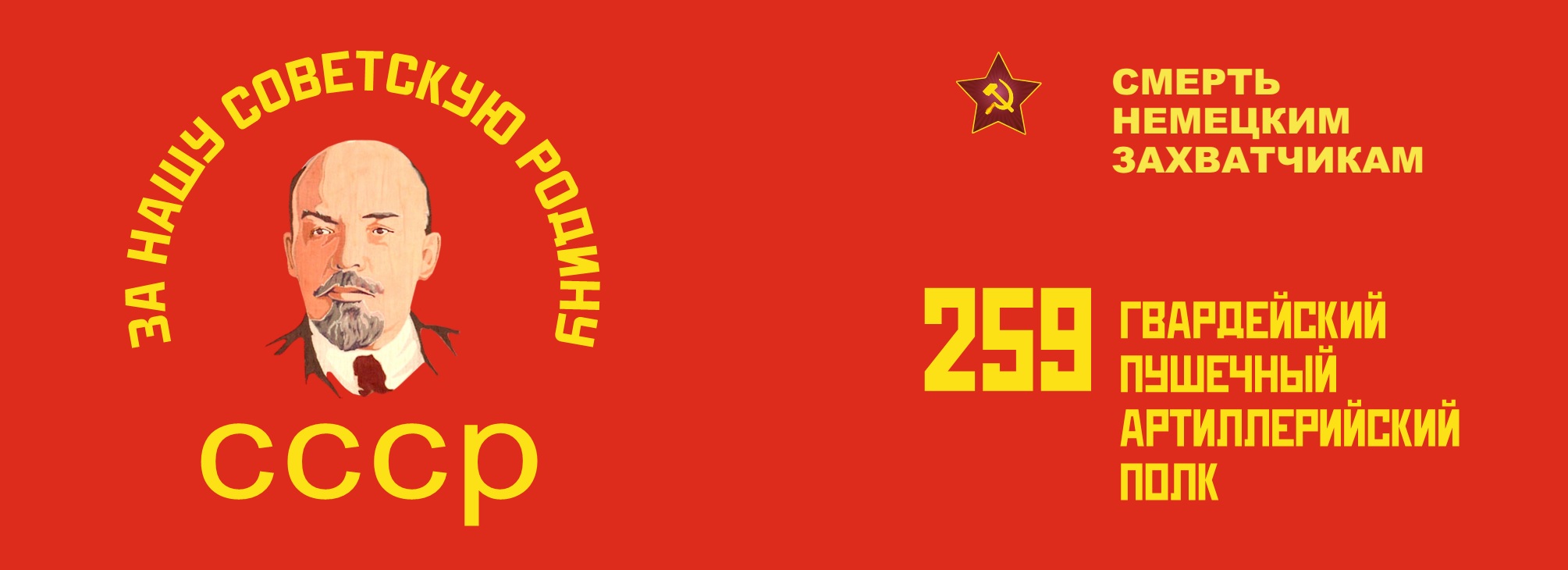
The (259) 123rd GUARDS CANNON ARTILLERY REGIMENT
In January 1932, the 259th Cannon Artillery Regiment was formed. He was stationed in the city of Tashkent. The chiefs of the regiment were the Tashkent Textile Combine and the Tashkent State Russian Drama Theater named after Gorky.
During World War II, from September 4 to October 1, 1942, the regiment participated in ensuring the 53rd Separate Central Asian Army’s campaign in Iran, and then departed for the Stalingrad Front, where it participated in battles as part of the 19th Heavy Artillery Division.
During the days of the counterattack, the regiment provided a breakthrough and offensive of the formations of the 64th Army and the 38th Rifle Division of the 57th Army.
For the valor, courage and heroism of the personnel, the regiment in 1943 was awarded the honorary guard rank and became called as the 123rd Guards Cannon Artillery Regiment of the RGK.
From July 15, 1943 to April 10, 1944, the regiment participated in breaking through the enemy’s defense and providing artillery fire for the 68th and 10th Guards armies to liberate the cities of Spas-Demensk, Yelnya, Roslavl, Smolensk, and Vitebsk.
As part of the troops of the 2nd Ukrainian Front, the artillerymen of regiment took part in the Chisinau operation in Iasi, in the battles to liberate Romania and Hungary.
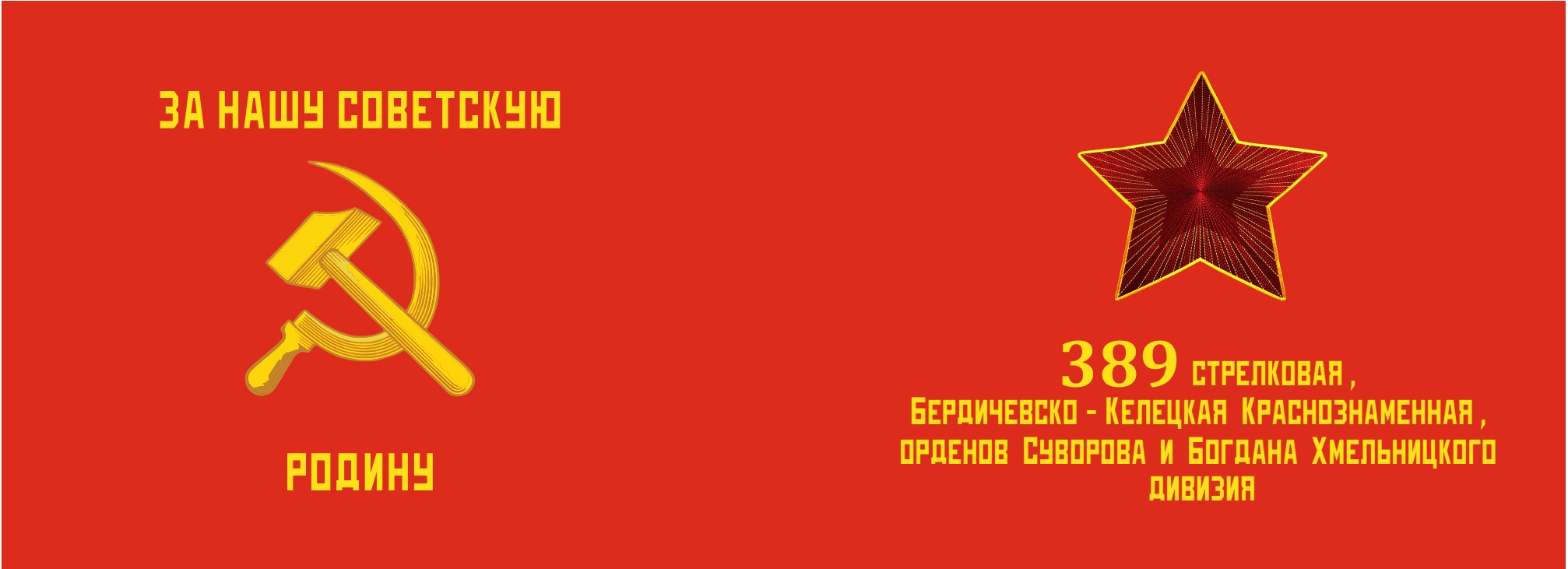
THE BATTLE FLAG
OF THE 389TH RIFLE BERDICHEV-KELECK, RED BANNERED, ORDERS OF SUVOROV AND BOGDAN OF THE KHMELNITSKY DIVISION
It was formed in October 1941 as part of the 53rd Army of the Central Asian Military District in the framework of the implementation of the Decree of the State Defense Committee of the USSR № 459 of August 11, 1941, led by the formation of the division Colonel I.M.Savin.
It was in the army from May 15, 1942 to May 11, 1945.
The 389th Rifle Division adopted baptism of fire on August 23, 1942.
The division took part in the Battle of the Caucasus and the liberation of Chechen-Ingushetia, North Ossetia, Kabardino-Balkaria, the Stavropol and Krasnodar Territories with access to the Sea of Azov, the breakthrough of the “Blue Line”, the liberation of Taman, the Zhytomyr-Berdychiv operation, the Lviv-Sandomir operation, Vistula-Oder operation, Lower Silesian offensive operation, Berlin offensive operation, and Prague operation. One of regiment of the division took part in the Temryuk landing in September 1943.
It liberated the cities: Ardon, Armavir, Slavyansk-on-Kuban, Krymsk, Temryuk, Berdichev, Gorokhov, Sokal, Glogau (Glogow), Kielce, Neystedtel (Nove-Miastechko), Ostrow (Ostrow Wielkopolski), Freistuvtad (Kozhuhtadt) (Kozhuhtadt).
Forced rivers: Terek, Ardon, Malka, Bolshaya Zelenchuk, Kuban, Western Bug, Vistula, Pilitsa, Oder, Neisse, Spree, Elba.
For the difference in the battles for the liberation of the city of Berdichev, the Order of the Supreme High Command № 56 dated on January 06, 1944, the division was given the honorary name “Berdichev”.
By the decree of the Presidium of the Supreme Soviet of the USSR of August 9, 1944, “For exemplary fulfillment of command assignments in battles with the German invaders during the breakthrough of the German defenses in the Lviv direction, for its valor and courage” it was awarded the Order of the Red Banner.
By order of the Supreme High Command № 012 of February 19, 1945, for the distinction in the battles to capture the city of Kielce, the division was given the honorary name “Kielce”.
On May 08, 1945 the division was awarded the Order of Suvorov of the 2nd degree for the capture of the Glogau fortress
The division was awarded the Order of Bogdan Khmelnitskyof the 2nd degree by Decree of the Presidium of the Supreme Soviet of the USSR of June 4, 1945 for exemplary performance of combat missions of command at the front, the fight against the German invaders during the liquidation of the group of German troops surrounded south-east of Berlin and shown at the same time valor and courage.
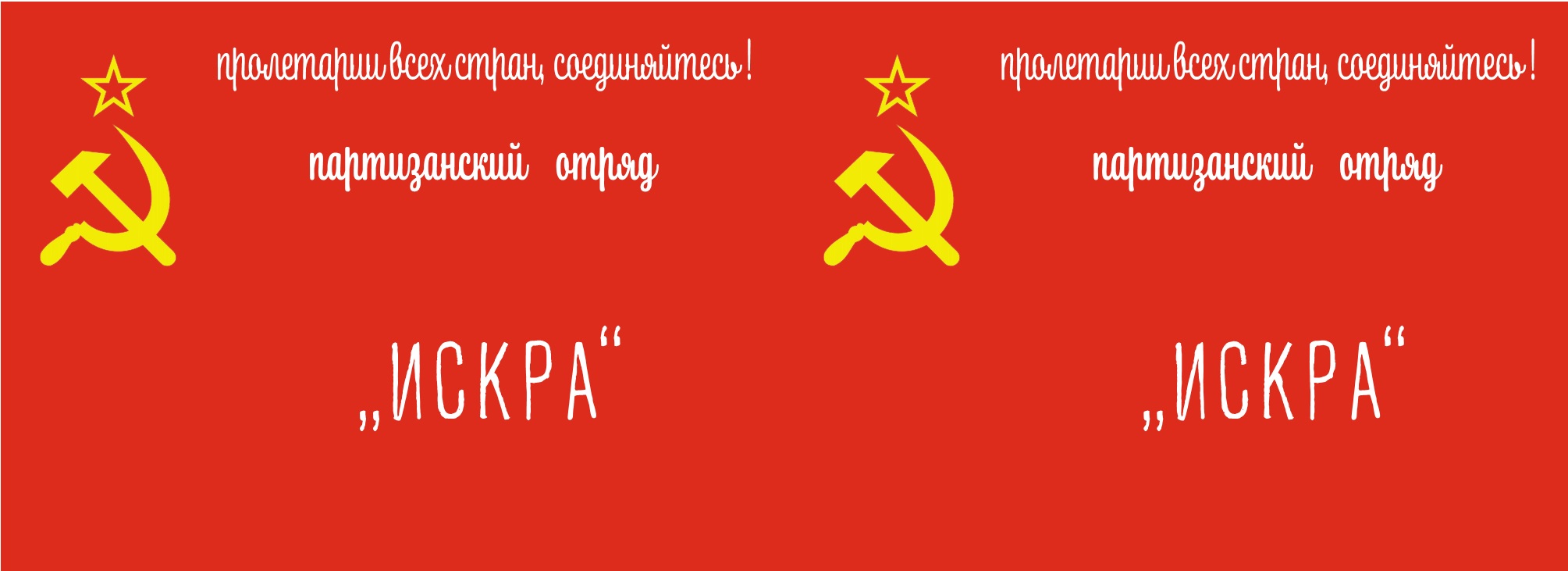
THE FLAG OF THE PARTISAN SQUAD “ISKRA”
OF THE BRIGADE “RAZGROM”
The Brigade “Razgrom” was one of the largest partisan formations operating in Belarus during World War II.
It was established in October 1942 on the basis of a decision of the inter-district underground committee of the Communist Party (b) of the Minsk Zone.
On July 2, 1944, the “Razgrom” brigade consisted of 6 detachments merged with the units of the Red Arm.y
The brigade included 6 units of about 2 thousand soldiers. The team operated on the territory of several districts of the Minsk region. It participated in major operations. It had accounted for about 300 wrecks of enemy trains and more than 14 and a half thousand Nazis killed. The partisans had their own printing house, sergeant school, hospital, and weapons workshop, where about 200 weapons were created. The “Iskra” detachment of the partisan brigade “Razgrom” was one of the most multinational among the partisan detachments of Belarus. Representatives of 15 nationalities fought in it. The “Iskra” partisan detachment had many soldiers from Uzbekistan:
V.P. Deryabin was the commander of the “Iskra” squad, lived and worked in the city of Tashkent before the war. He personally organized the “Iskra” partisan detachment. He was awarded the Order of the Red Banner, the Order of Lenin, the medal “Partisan of the Patriotic War” of 1st degree
TashniyazovGantai was the commander of the sabotage group of the “Iskra” squad. He was born in the city of Tashkent. He had been a participant of the war since 1941. he heroically died in February 1944 in a battle near the village of Smyki. He was awarded the Order of the Red Star, the Order of the Patriotic War of 1st degree. He was awarded the title of “The Hero of the Soviet Union”, but the plane with the documents was shot down.
KhalikovMamayakub was the demoman of the “Iskra” partisan detachment. He was born on the Pravda collective farm in the Yatkurgan region. He participated in undermining the enemy’s echelons. When the German garrison was defeated in the village of Peshkovka on May 28, 2004, he was wounded and sent to the Great Land. He died of wounds in April 1945. He was awarded the Order of the Red Banner, the Order of the Red Star.
Prokopiev Ivan Alekseevich was the political instructor of the “Iskra” squad. He was born in the city of Fergana. He was awarded the Order of the Red Star.
The Battle Flag was made of a children’s blanket and hand-embroidered by the women of the “Iskra” squad.
The original flag of the “Iskra” partisan detachment is stored in the State Museum of the History of the Great Patriotic War of the Republic of Belarus.

The History of Battle Flags goes back a long way. In ancient times, in different states, flags were of all kinds and sizes. They were made from hay on the ends of long stalks to fabrics embroidered with precious threads. For the Greeks and Romans, they were only a handle, on top of which a figurine of an animal or bird (wolf, owl, eagle) was attached, and among the Chinese and Indians, a handle with a cloth that had a picture or various symbols
The Battle Flag of a military unit is an official symbol of a military unit, personifies its honor, glory and military traditions, indicates the mission of the military unit and its affiliation.
The battle flag has always been important. Homeland and Honor are two interconnected ideals embodied in a battle flag. Every warrior must sacrifice his life to protect the banner.
The Battle Flag must be always in the military unit and is kept in the area where the military unit is engaged in hostilities. All personnel of the military unit must valiantly defend the Battle Flag during the battle and prevent it from capturing by the enemy.
In case of loss of the Battle Flag, the commander of the military unit and other military personnel will be found guilty of this disgrace and will be sent to a military court, and the military unit will be disbanded.
In exceptional cases, with the immediate danger of the capture of the Battle Flag by the enemy and the absence of a real possibility of his defense and rescue, the Battle Flag must be destroyed by order of the commander of the military unit.
VICTORY BANNER



